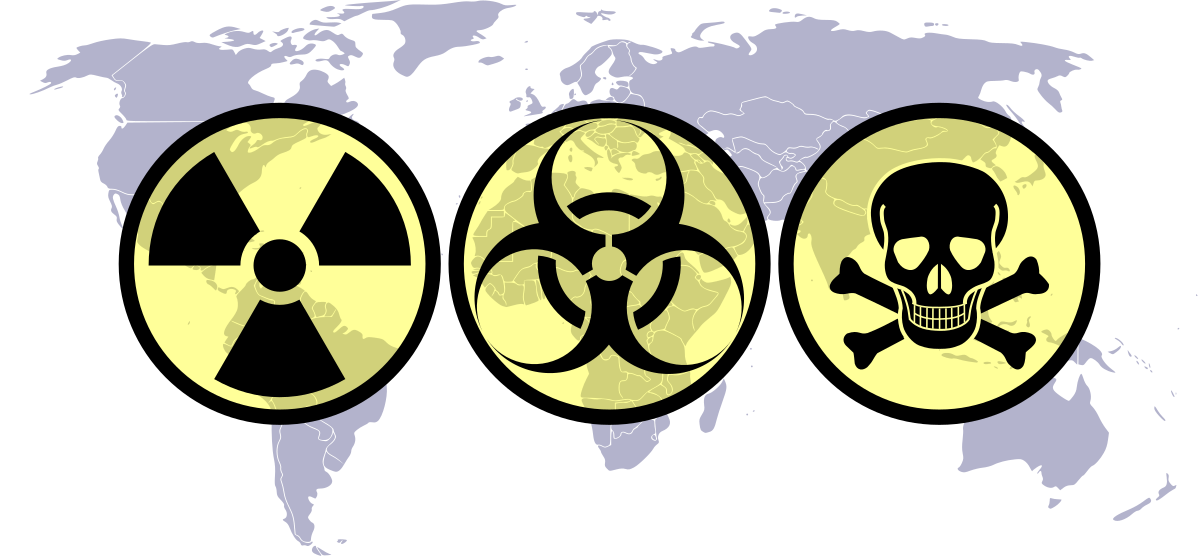


|
Welcome to the 21st Century -  age of neo-eugenics Capt Wardrobe July 2021
|

|
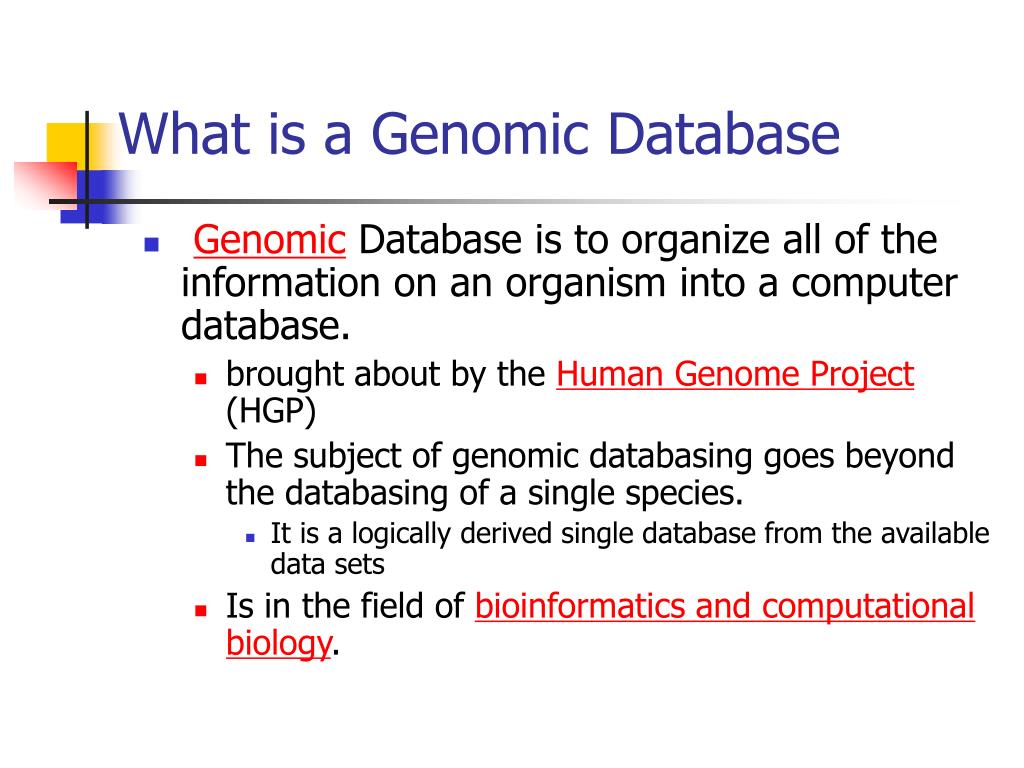
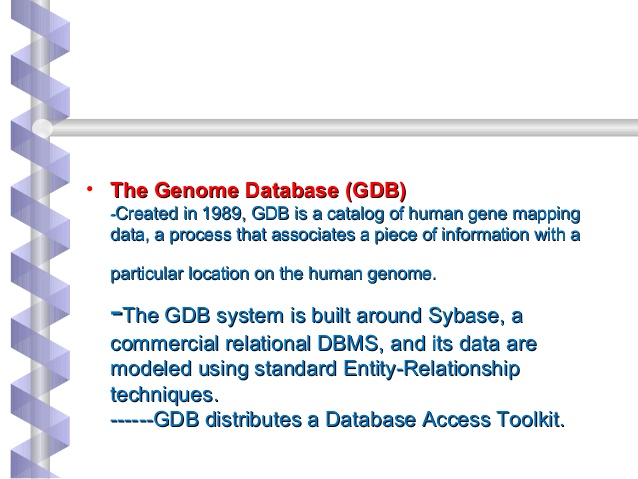
|
Milestones in genomics
1953 - the DNA double helix structure is identified
1961 - genetic code deciphered
1977 - Sanger sequencing is developed
1983 - polymerase chain reaction (PCR) is developed
1990 - Human Genome Project begins
1999 - first human chromosome (22) is sequenced
2003 - Human Genome Project is completed
2013 - first multi-gene sequencing diagnostic test for tumour profiling in the NHS
2015 - first patients enrolled in 100,000 Genomes Project receive diagnoses
2017 - release of genome-wide genotype data on all 500,000 UK Biobank participants
2020 - routine use of whole genome sequencing in the NHS
1985 - first NHS funded DNA diagnostic service is launched
1997 - DNA sequencing used within NHS diagnostic services
2001 - molecular testing for BRCA1 and BRCA2 mutations in high-risk families
2007 - landmark Wellcome Trust Case Control Consortium genome wide association study of seven common diseases
2012 - UK government announces 100,000 Genomes Project
2018 - 100,000 Genomes Project reaches its target of 100,000 whole genomes sequenced
2020 - first 50,000 UK Biobank participants receive a whole genome sequence
|

"Lobbying at the international level: the I.P.P.F. has a strong influence on the UN and on its agencies like the UNICEF (the UNICEF subsidizes the family planning activities), the WHO and the UNESCO (the first general secretary of the UNESCO, Sir Julian Huxley, was the president of the English Eugenics Society). The international conferences about population, organized by the UN, are due to the eugenicist initiatives. - |
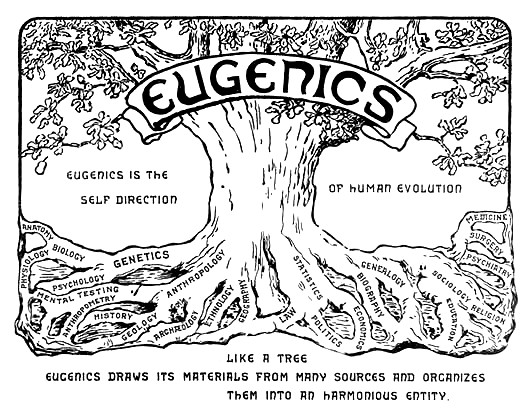 |
“The Vital Importance of Eugenics” (1933) Sterilization of the unfit and identification of carriers of defective genotypes Huxley argued that the principle goal of eugenics in the short term should be to ensure that mentally defective individuals cease having children. He advocated in particular for:
· Prohibition of marriage of the unfit
However, Huxley was not particularly concerned with the specifics of how short-range eugenics were implemented, so long as degenerate individuals were stopped from reproducing as quickly as possible. He additionally lamented that the process of eliminating feeble-mindedness from the population would be a particularly difficult task, due to the recessive nature of certain genes coding for mental defects. Therefore, he proposed that one of the long-term goals of eugenics should be the discovery of a method through which carriers of genes for mental deficiency could be accurately diagnosed, though these individuals do not exhibit defective traits themselves. If carriers could be identified before they reproduced, Huxley argued, then eugenicists would have yet another tool at their disposal with which to stop degenerate germ plasm from infiltrating future generations (Huxley, 1933: 325). |
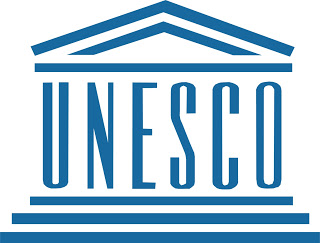 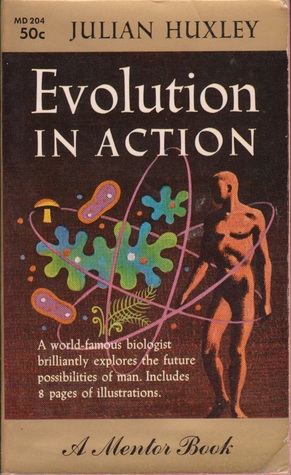
|

"UNESCO Director-General Irina Bokova will advocate for the cause of inclusive development and resilience as she joins global leaders at the 46th Annual Meeting of the World Economic Forum in Davos from 20 to 23 January 2016. The overarching theme of this year’s meeting is “Mastering the Fourth Industrial Revolution,” – how to make rapid change work for inclusion, security and prosperity." “This year’s theme dovetails with the universal 2030 Agenda for Sustainable Development and the Paris Climate Agreement adopted in 2015,” explains the Director-General. “Fundamentally, it is about how we lead change, collaborate and innovate to empower people and make this a peaceful and inclusive development revolution." UNESCO
|
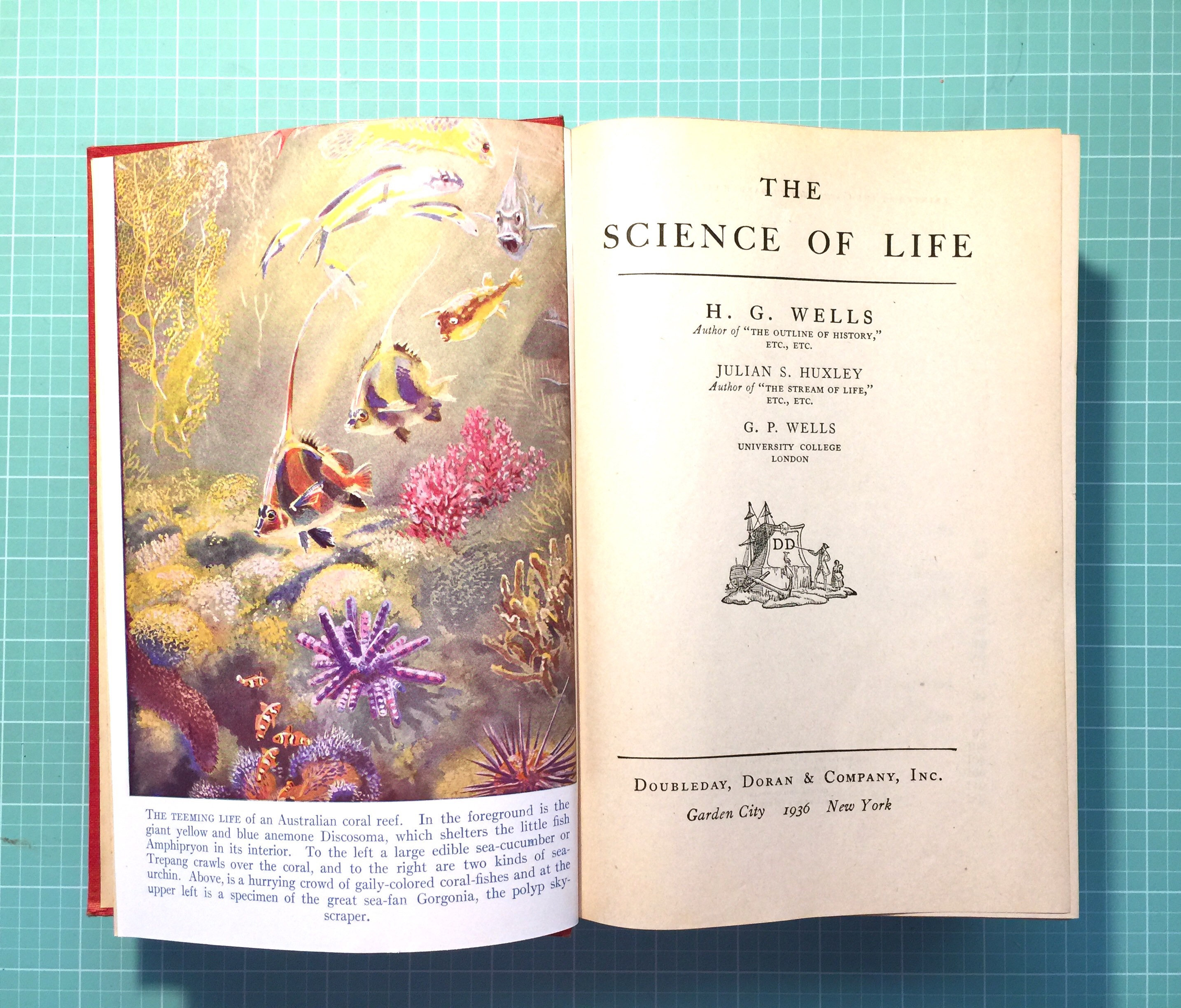 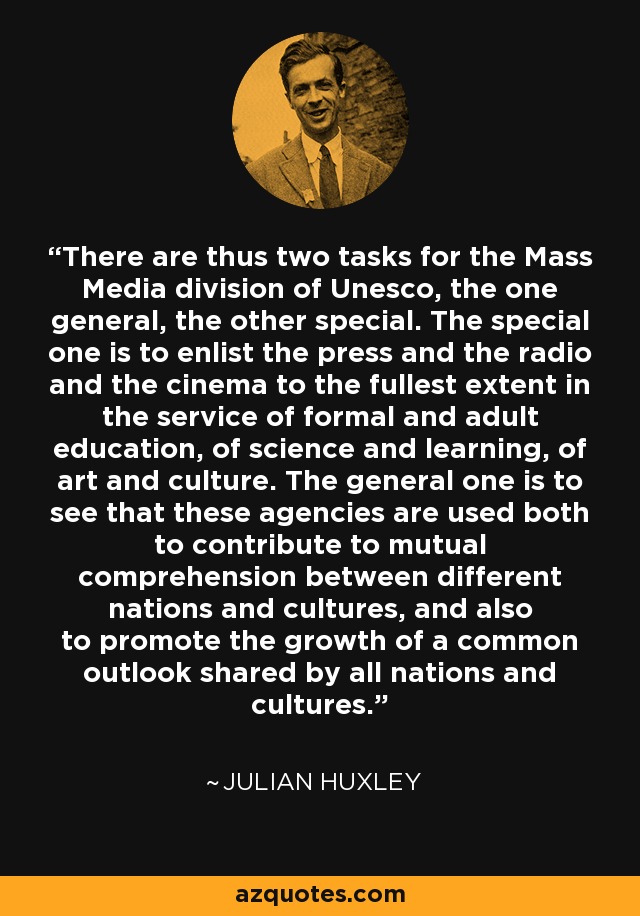
|
|
|
Julian & Aldous Grandfather, Thomas Henry Huxley was known as
Darwins Bulldog:
A distraught, overworked Huxley resigned his professorship at the Normal School of Science
(the future novelist H.G. Wells sat his last course) ]
an critic or supporter of Eugenics? book [pictured left] mentions Huxley Sr as influence on HG Wells.
...the man who brought us War Of the Worlds / The Time Machine and political writings such as
The Open Conspiracy; Blue Prints for a World Revolution
A Modern Utopia
and "The shape of things to come" [linked below]
more works here
& here
HG Wells made a major contribution to the forming of the League of Nations.
...and it's surely just a coincidence that Julian Huxley went on to be first Director-General of UNESCO one of the major players in the formation of UN Agenda 21 / and UN Agenda 2030...
Julian Huxley coined the term "transhumanism" in 1957.
while his brother, Aldous, experimented with LSD [linked to Sandoz Pharma & CIA - see; MK Ultra] wrote pretend sci fi treatise on the actual plan for humanity. see Brave New World & The Doors of Perception.
|
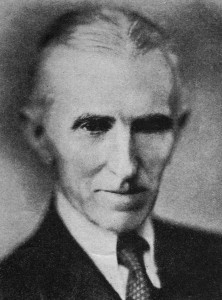 |
The February 9, 1935 issue of Liberty magazine includes many other fascinating predictions by Tesla for the future of humanity, which we’ll no doubt look at in the weeks ahead. But for the time being I’ve transcribed only the eugenics portion of Tesla’s predictions below, to remind us that we should be cautious when making gods of men:
The year 2100 will see eugenics universally established. In past ages, the law governing the survival of the fittest roughly weeded out the less desirable strains. Then man’s new sense of pity began to interfere with the ruthless workings of nature. As a result, we continue to keep alive and to breed the unfit. The only method compatible with our notions of civilization and the race is to prevent the breeding of the unfit by sterilization and the deliberate guidance of the mating instinct. Several European countries and a number of states of the American Union sterilize the criminal and the insane. This is not sufficient. The trend of opinion among eugenists is that we must make marriage more difficult. Certainly no one who is not a desirable parent should be permitted to produce progeny. A century from now it will no more occur to a normal person to mate with a person eugenically unfit than to marry a habitual criminal.
Smithsonian
|
|
The central idea behind the Great Reset is transhumanism. Transhumanism, a loosely-defined movement that has developed over the last decades, aims to enhance human conditions through science based on a mechanistic understanding of nature. With a knowledge paradigm that aims to dominate and control nature, transhumanists try to chart an inorganic path of evolution. Their goals are to go beyond the biological limit of the human condition, and to attain far greater human capacities than displayed at present, by merging humans with the machine.
The foundation of transhumanism was laid within the ideology of Social Darwinism, which became prominent during the late 19th century. English philosopher Herbert Spencer, after reading Charles Darwin’s book “On the Origins of Species,” sought to apply Darwin’s idea of biological evolution to the social realm. By coining the term “survival of the fittest,” Spencer described processes that Darwin has called “natural selection” in mechanical terms.
Spencer’s interpretation, emphasizing superiority of physical forces, fostered Social Darwinists’ view that the strongest and most capable individuals in a population should be allowed to thrive without restriction, while the weak should not be prevented from dying out. This sociological theory cemented the idea of biological determinism and this was used to justify modern predatory capitalism, which allows the wealthy few to ruthlessly exploit and prosper.
|
cultural PROGRAMMING
|

|
Dominic Cummins blog...Dangerous Eugenics & Designer babies...
There are many big implications. This will obviously revolutionise IVF. ~1 million IVF embryos per year are screened worldwide using less sophisticated tests. Instead of picking embryos at random, parents will start avoiding outliers for disease risks and cognitive problems.
Rich people will fly to jurisdictions offering the best services.
|
|
Chatham House - Elitist fUturescaping
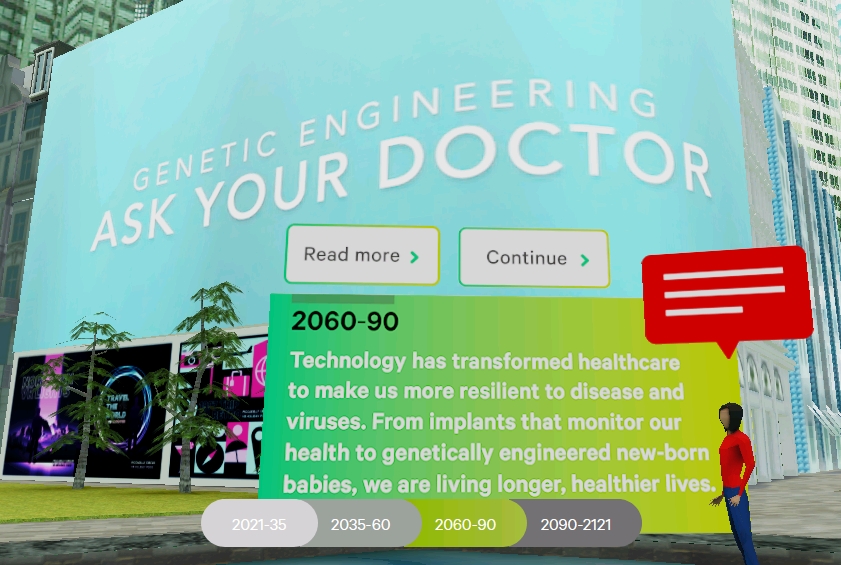
|
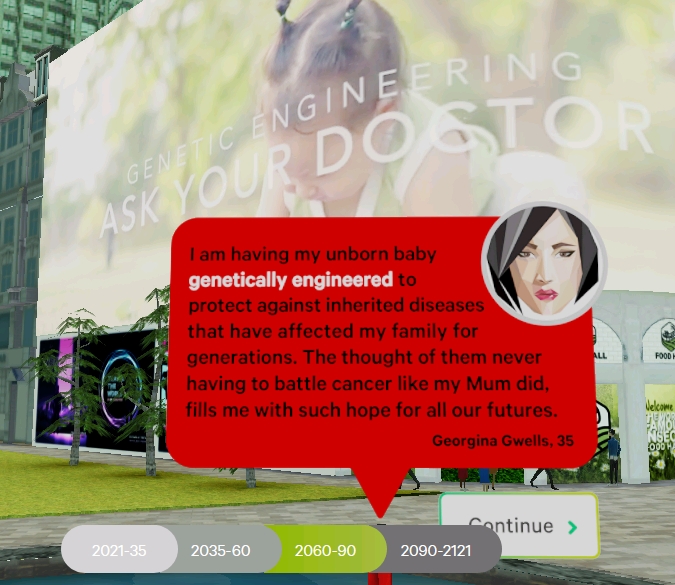
|
 |
Transhumanism And The Future Of Humanity: 7 Ways The World Will Change By 2030 The coming years will usher in a number of body augmentation capabilities that will enable humans to be smarter, stronger, and more capable than we are today. Wearables will be one form of body augmentation, but they will far surpass the fitness trackers of today. In the future, we can expect the arrival of contact lenses that can take pictures or video, universal language translator earbuds that allow us to communicate anywhere in the world, and exosuits that increase physical strength. |
|
We will also see increased use of implants ranging from brain microchips and neural lace to mind-controlled prosthesis and subdermal RFID chips that allow users to unlock doors or computer passwords with the wave of a hand.
However, the most powerful body augmentation will come from biological augmentation as a result of increased insight into our genomes, advances in IVF technology that may allow us to select the most intelligent embryos, and powerful CRISPR gene-editing technology which may one day give us the ability to eliminate all heritable diseases. These body augmentation capabilities will give rise to humans that are more resilient, optimized and continually monitored. |
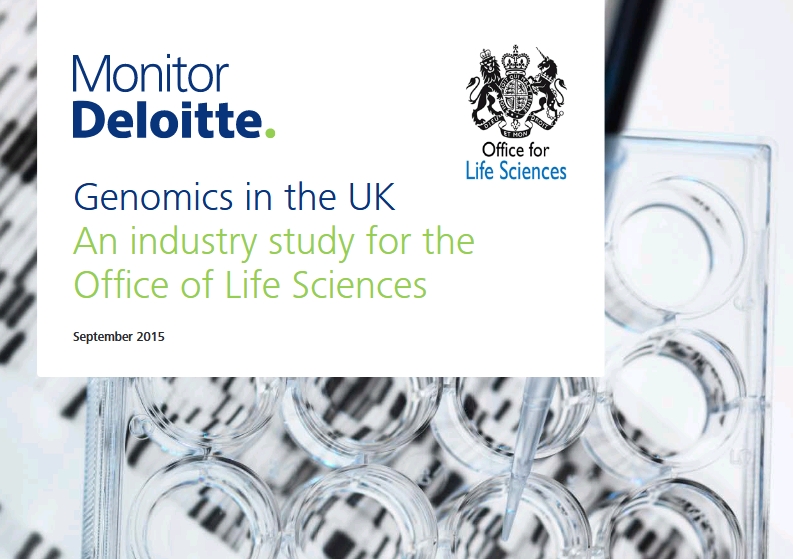
|
excerpts from a 2015 report on The Genomics industry by Deloitte
Recent government initiatives in genomics
The 100,000 Genomes Project was launched by the UK government in 2012 with the aim of sequencing 100,000 human genomes, setting up a genomic medicine service for the NHS, enabling new scientific discovery and kick-starting the development of the UK genomics industry. It will initially focus on rare diseases and cancer and has received over £200 million in investment.
The US Precision Medicine Initiative was announced by President Obama in his 2015 State of the Union Address, with the aim of investing £130 million to test at least one million volunteers to see how their genomic data and other health information will help understand how genes interact with environmental factors. This research will be used to advance pharmacogenomics, identify new targets for treatment and prevention, test the role of mobile devices in encouraging health behaviours and lay the scientific foundation for precision medicine.
|
|
The Saudi Human Genome project was launched in late 2013 and funded by the Saudi Arabian National Science Agency. It aims to create a DNA database to develop precision medicine and up to 100,000 people in Saudi Arabia are expected to have their genetic codes mapped. Research will take place at 10 genome centres across Saudi Arabia with another five expected to be created.
The Stratified Medicine Scotland (SMS) Innovation Centre was launched in 2014. It aims to create capacity to serve the health needs of the Scottish population, improving both diagnosis and treatment of diseases. The SMS Innovation Centre will have the capability to link phenotype and genotype data together to better predict patient response to individual therapy. Projects include identification of additional genetic mutations to improve treatments for cancers. There is also a funded programme for an MSc in Stratified Medicine and Pharmacological Innovation, a joint degree offered by the Universities of Aberdeen, Glasgow and Strathclyde
Beginning with healthcare systems, the investment in translatable genomics and precision medicines is cost-effective if the targeted nature of treatment improves patient outcomes whilst reducing overall costs compared to the current model of care (for a given level of health improvement), a measurement known as QALY. For example a drug that was traditionally provided to all repatients might only receive a response from some patients whilst others suffer adverse events. In a successful personalised medicine model, where only patients with a relevant biomarker are treated, more patients will respond to treatment and there will be fewer or no adverse events. For this model to be a reality there are a number of conditions that must be met:
biomarker information for all patients |
|
The Future of healthcare UK Government
Lord Bethell(Conservative)
Title created: 1922
Aged: 50
Education: Harrow
Who: James Bethell, the 5th Baron Bethell. Heads the Westminster lobbying company Westbourne Communications.
What he says: “As the founder of a successful company, I am in the position to hand over the reins and commit myself to supporting the Government in the House of Lords.”
The National Genomic Healthcare Strategy
Following on from the launch of the National Genomic Healthcare Strategy in 2020, what are the next steps towards putting these ambitious plans into practice for patient benefit?
Catch up with our online discussion, held on 24 May 2021. Hear from Minister for Innovation, Lord Bethell, as he reflects on plans for implementation over the coming year, followed by a short panel discussion between some of the UK’s leading experts.
|
Lord Bethell of Romford back in 2015
Over the next 10 years our ambition is to create the most advanced genomic healthcare system in the world, underpinned by the latest scientific advances, to deliver better health outcomes at lower cost.
We will do this by working together across our four nations and reducing boundaries between clinical care and research. We will support earlier detection and faster diagnoses, use genomics to target interventions to specific groups of patients, support patients in understanding what genomics means for their health, and bring the full might of our capabilities in this field to bear against new global pandemics and threats to public health. This will support the commitments, set out in the 2019 Conservative manifesto[footnote 1] to invest in world class computing and health data systems that can aid research and make the UK the leading global hub for life sciences.
In this strategy we set out an exciting and compelling vision for the future which is focused on 3 key areas:
Diagnosis and personalised medicine
We will incorporate the latest genomics advances into routine healthcare to improve the diagnosis, stratification and treatment of illness. We will focus on:
the NHS England Genomics Medicine Service: we will be the first national healthcare system in the world to offer whole genome sequencing (WGS) as part of routine care, delivering on our promise to sequence 500,000 whole genomes.
pharmacogenomics: we will enable the most effective provision of effective therapies so that patients get the treatments and advice that work for them, including tailoring drug treatments.
cancer: we will introduce a new operating model for cancer, ensuring multi-disciplinary teams can draw on a range of genomic, imaging and longitudinal health and care data to improve patient outcomes.
Prevention
Enabling predictive and preventative care to improve public health and wellness. We will focus on the role genomics can play in:
expanding screening in early life: the UK is uniquely positioned to conduct a high quality, large-scale research programme to determine whether and how sequencing should implemented for screening in newborns. We will study the opportunities, risks, ethical issues, and regulatory implications of such a programme, ensuring that we progress a public conversation to generate better understanding of patient and public attitudes.
targeted screening: we aim to better use genomics to improve population health through improved disease prevention including better screening. This includes the use of personalised and risk stratified screening and testing of the family members of cancer patients to identify where they are at increased risk of cancer. We also expect to see development of non-invasive prenatal testing using sequencing to identify diseases.
Research
Supporting fundamental and translational research and ensuring a seamless interface between research and healthcare delivery. We will focus on:
data to support innovation: we will make the UK the best place in the world to access genomic data for research. We will also get the underpinning infrastructure and standards right, and coordinate the development and adoption of standardised data access processes, tools and conventions for the major health data controllers.
responsible use of data: we want genomics to be an exemplar for the responsible use of health data for patient benefit and will make this a core tenet of our approach.
ensuring diversity and equity of access: we will develop robust systems of outreach and communication to diversify our genomic datasets. This will address the ethnic bias historically seen in most large genetic datasets and help ensure equity of access to genomic healthcare.
Alongside these 3 pillars, we will focus on 5 cross-cutting themes:
engagement and dialogue with the public, patients and our healthcare workforce, placing the patient and the diverse UK population at the heart of this journey.
workforce development and engagement with genomics through training, education and new standards of care.
supporting industrial growth in the UK, facilitating entrepreneurship and innovation for projects and companies of all sizes, through common standards, funding, procurement, and R&D structures
maintaining trust through strong ethical frameworks, data security, robust technical infrastructure and appropriate regulation.
delivering nationally coordinated approaches to data and analytics. This will enable healthcare professionals and approved researchers to easily access and interpret our world-leading genomic datasets.
|
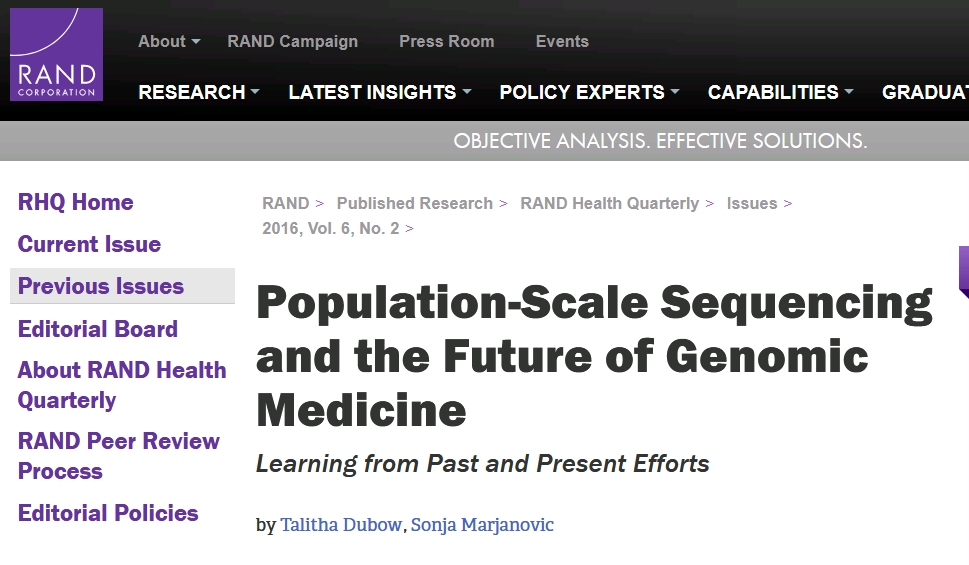 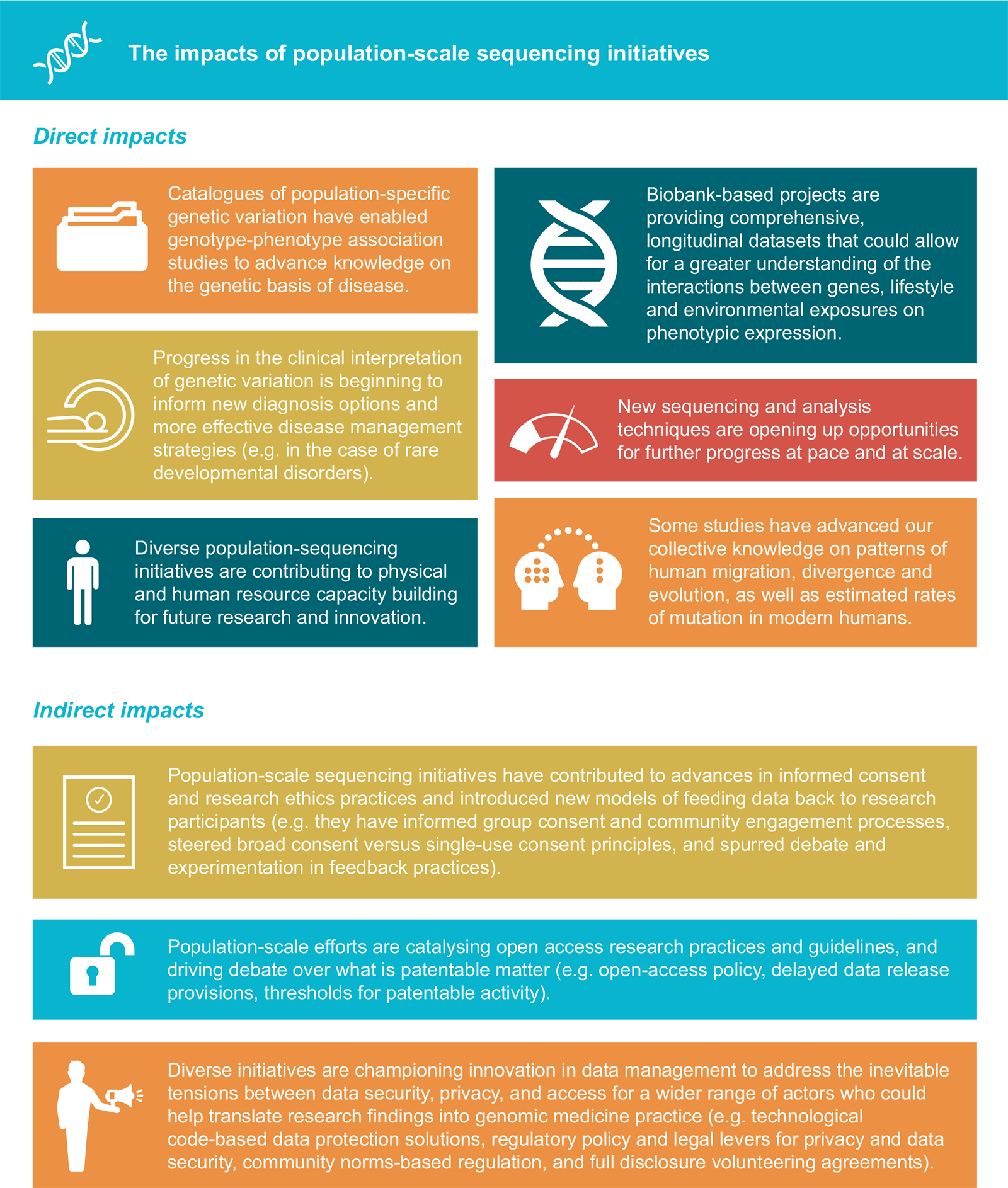
|
RAND Report - 2016
Population-Scale Sequencing and the Future of Genomic Medicine
Genomic medicine, as a field, has the potential to change the way we prevent, manage and treat disease. Although the routine implementation of genomic medicine in clinical care is yet to be realised, diverse national and international initiatives are narrowing the gap between prospect and practice.
This study provides a reflection on the variety of population-scale genome-sequencing efforts that have emerged over the past two decades and examines their social implications.
We analyse the progress these initiatives have made, both in terms of their scientific, technological and biomedical contributions, and in terms of their influence on the institutions that govern science and innovation more widely.
Based on our analysis, we identify five areas of action for a future research and policy agenda to consider. These span issues related to:
i) the scale-up of existing efforts and the need for more cross-sector collaboration for clinically-relevant sense-making;
ii) the implications of genomics in clinical settings;
iii) changes in industry R&D models that are likely to accompany further advances in genomic medicine;
iv) consolidating learning about appropriate research ethics frameworks and clarifying the legal arrangements necessary for genomic medicine; and
v) wider evaluation and learning from past and current efforts.
|
|
List of Profiled Initiatives
The 30 initiatives covered in this study are listed below,
sorted according to the scope of their sample collection (either national or international):
International
The Human Genome Diversity Project (HGDP)
The International HapMap Consortium
The Global Network of Personal Genome Projects (PGP)
The 1000 Genomes Project
The Human Heredity and Health in Africa (H3Africa) Initiative
The African Genome Variation Project
The Cohorts for Heart and Aging Research in Genomic Epidemiology (CHARGE) Consortium
The International Cancer Genome Consortium (ICGC)
National
deCODE genetics (Iceland) |
|
from the Deloitte report
Illumina
was founded in 1998, borne from the discovery of Bead Array technology at Tufts University.
The company quickly raised initial funding of £5.4 million and used this to develop core technology and an intellectual property portfolio. Illumina negotiated an exclusive license for its Bead Array technology and completed its initial public offering just two years later in 2000. In 2001, the company began offering genotyping services and consistently developed new services and benchtop systems.
It conducted some strategic acquisitions and focused on commercialising an expanding product portfolio.
However, until the acquisition of Solexa, a UK-based genomic-scale sequencing technology, Illumina did not have the complete tool set for genomic analysis. The acquisition in 2006 saw revenues double.
[FROM THE UK GOV Report]
Genomics in practice: Illumina Accelerator
Illumina recently announced the expansion of its Accelerator to Cambridge. Founded in the San Francisco Bay Area in 2014, the Illumina Accelerator focuses on partnering with entrepreneurs to build breakthrough genomics start-ups. During each 6-month funding cycle, the Illumina Accelerator will provide selected start-ups with access to seed investment, access to Illumina sequencing systems and reagents, as well as business guidance, genomics expertise, and fully operational lab space adjacent to Illumina's campus in Cambridge. Since launching in 2014, Illumina Accelerator has invested in 33 genomics start-ups from across the globe, which have collectively raised over $300 million in venture capital funding.
see also Illumina.com
|
|
"We all now live in a world where knowing our genetic makeup, down to the individual chromosomes, is not only possible, but affordable. It will be soon be the norm."
|
Jay Flatley
ex-Chairman of Illumina
Building a gene sequencing empire
Mr. Jay T. Flatley is
a Chairman at Zymergen, Inc.,
a Chairman at The Wellcome Trust Ltd.,
a Chairman at Iridia, Inc.,
an Independent Director at Denali Therapeutics, Inc.,
an Independent Director at Coherent, Inc.,
an Executive Chairman at Illumina, Inc.
and a Chairman at Helix Holdings I LLC.
He is on the Board of Directors at Denali Therapeutics, Inc.,
Coherent, Inc., GenVault Corp., Helixis, Inc., Keck Graduate Institute of Applied Life Sciences and
The Salk Institute for Biological Studies.
Mr. Flatley was previously employed as an Independent Director by Juno Therapeutics, Inc.,
a Co-Founder by Helix OpCo LLC, a President & Chief Executive Officer by Bruker AXS, Inc.,
a President, Chief Executive Officer & Director by Molecular Dynamics, Inc.,
a Vice President-Engineering & Strategic Planning by Plexus Computers LLC,
a Chairman by GRAIL, Inc., an Executive Vice President by Manning Technologies, Inc.,
and an Executive Vice President-Manning Technologies by Spectra-Physics, Inc.
He received his undergraduate degree from Stanford University, an undergraduate degree from Claremont McKenna College and a graduate degree from Stanford University.
|
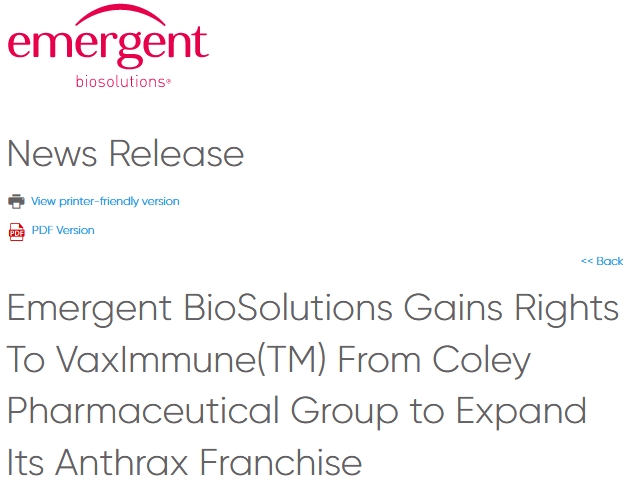
|
About Emergent BioSolutions Inc.
Emergent BioSolutions Inc. is a biopharmaceutical company focused on the development, manufacture and commercialization of immunobiotics, such as vaccines and therapeutics that induce or assist the body's immune system to prevent or treat disease. The company's biodefense business is focused on developing and commercializing immunobiotics for use against biological agents that are potential weapons of bioterrorism. The company's commercial business is focused on developing immunobiotics for use against infectious diseases which pose significant unmet or underserved public health needs. More information on the company is available at www.emergentbiosolutions.com.
|
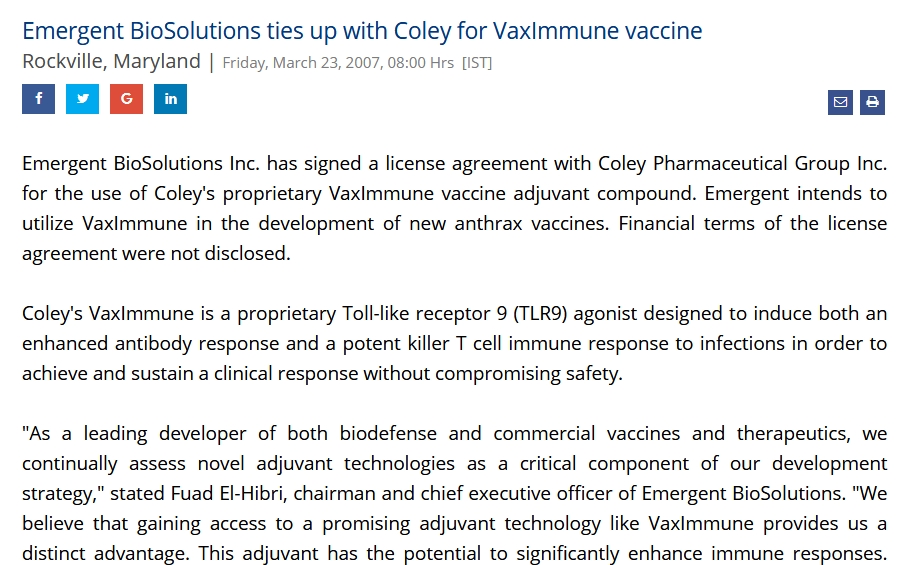
|
Emergent BioSolutions ties up with Coley for VaxImmune vaccine
2007
The agreement allows the company to build on promising data from a phase I clinical study funded by the defense advanced research projects agency (DARPA) of the DoD. This double-blind phase I clinical trial was designed to evaluate the safety and immunogenicity of a combined product candidate using BioThrax and VaxImmune compared to BioThrax alone and VaxImmune alone. This human trial, developed through collaboration among DARPA, Coley and Emergent BioSolutions, and completed in 2005, involved 69 healthy volunteers and used a three-dose regimen and intramuscular route of administration.
source
Emergent BioSolutions Signs Contract with BARDA/NIAID,
Valued at Up to $29.7 Million, to Fund Development of AV7909 - A Next Generation Anthrax Vaccine
source
|
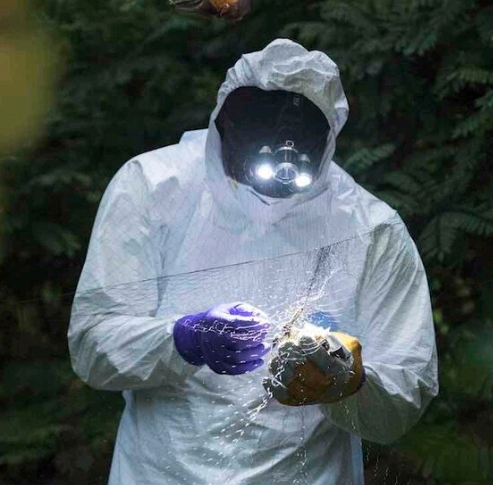
|
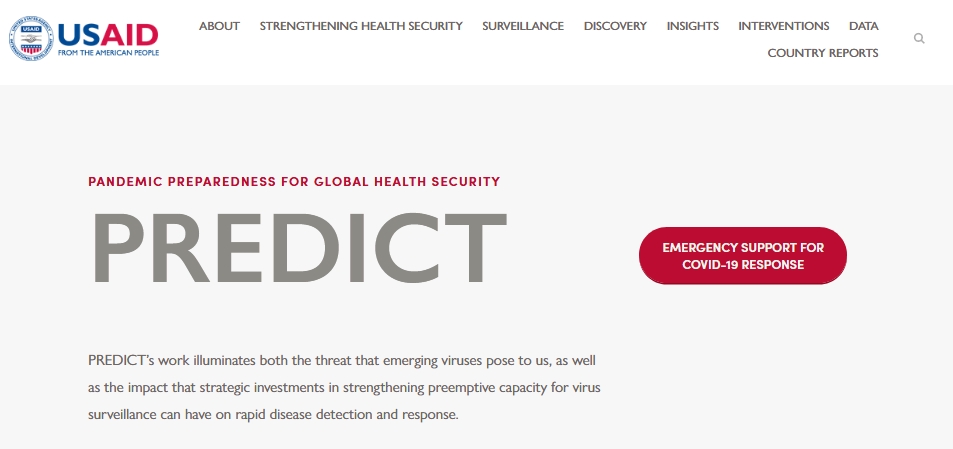
|
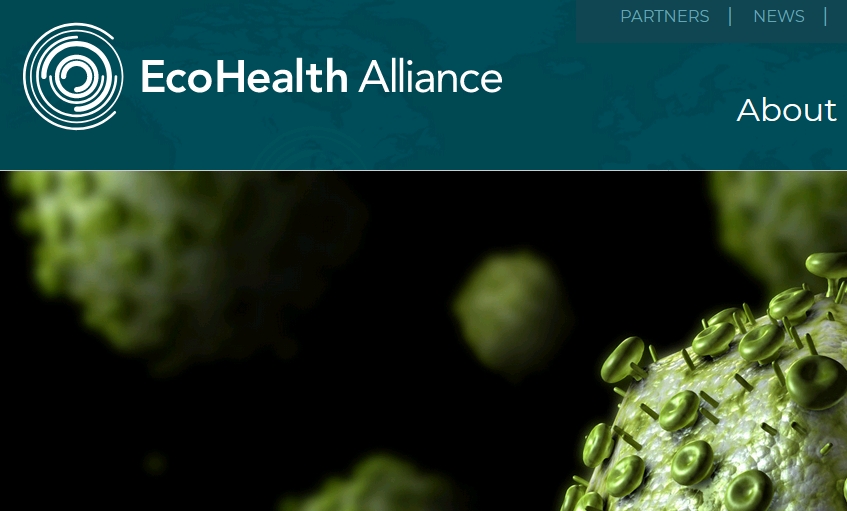
|
Dr. Peter Daszak
is President of EcoHealth Alliance, a US-based organization that conducts research and outreach programs on global health, conservation and international development. Dr. Daszak’s research has been instrumental in identifying and predicting the origins and impact of emerging diseases across the globe. This includes identifying the bat origin of SARS, the drivers of Nipah virus emergence, publishing the first global emerging disease ‘hotspots’ map, discovering SADS coronavirus, designing a strategy to identify the number of unknown viruses in wildlife, launching the Global Virome Project, identifying the first case of a species extinction due to disease, and discovering the disease chytridiomycosis as the cause global amphibian declines. He is one of the founders of the field of Conservation Medicine and has been instrumental in the growth of EcoHealth, One Health, and now Planetary Health.
A fundamental part of the Dr. Daszak’s work on disease ecology is directed by the conviction that disease outbreaks are not just predictable, but preventable. This approach is informed by a perspective on emerging infectious disease research that sees problems of human and animal disease as intimately linked – exacerbated by ecological change. With this in mind, he led the researcher that produced the first ever global emerging disease ‘hotspots’ map to determine where in the world viruses with pandemic potential are most likely to emerge, and developed a strategy to identify just how many of those viruses currently exist.
[left]WHO Expert Peter Daszak Boasts About Manipulation Of Killer SARs Like Virus In Wuhan | India First
|
|
To be strictly fair to the media, Daszak’s EcoHealth Alliance obscures its Pentagon funding. On its website EcoHealth Alliance states that “A copy of the EHA Grant Management Manual is available upon request to the EHA Chief Financial Officer at finance ( at ) ecohealthalliance.org”. But an email to that address and numerous others, including Peter Daszak’s, requesting that Manual, as well as other financial information, was not returned. Neither were repeated voicemails.
Only buried under their “Privacy Policy,” under a section titled “EcoHealth Alliance Policy Regarding Conflict of Interest in Research,” does the EcoHealth Alliance concede it is the “recipient of various grant awards from federal agencies including the National Institute of Health, the National Science Foundation, US Fish and Wildlife Service, and the US Agency for International Development and the Department of Defense.”
Even this listing is deceptive. It obscures that its two largest funders are the Pentagon and the State Department (USAID); whereas the US Fish and Wildlife Service, which accounts for a minuscule $74,487, comes before either.
Meticulous investigation of U.S. government databases reveals that Pentagon funding for the EcoHealth Alliance from 2013 to 2020, including contracts, grants and subcontracts, was just under $39 million. Most, $34.6 million, was from the Defense Threat Reduction Agency (DTRA), which is a branch of the DOD which states it is tasked to “counter and deter weapons of mass destruction and improvised threat networks.”
Most of the remaining money to EHA was from USAID (State Dept.), comprising at least $64,700,000 (1). These two sources thus total over $103 million.
Summary of EHA Grants and Contracts. Note this figure doesn’t count subcontracts so it undercounts USAID’s contribution, see footnote (1) below (Credit: James Baratta and Mariamne Everett)
Another $20 million came from Health and Human Services ($13 million, which includes National Institutes of Health and Centers for Disease Control), National Science Foundation ($2.6 million), Department of Homeland Security ($2.3 million), Department of Commerce ($1.2 million), Department of Agriculture ($0.6 million), and Department of Interior ($0.3 million). So, total U.S. government funding for EHA to-date stands at $123 million, approximately one third of which comes from the Pentagon directly. The full funding breakdown is available here and is summarized by year, source, and type, in a spreadsheet format.
The military links of the EcoHealth Alliance are not limited to money and mindset. One noteworthy ‘policy advisor’ to the EcoHealth Alliance is David Franz. Franz is former commander of Fort Detrick, which is the principal U.S. government biowarfare/biodefense facility.
|
|
David Franz was part of UNSCOM which inspected Iraq for alleged bioweapons — what were constantly referred to as WMDs or Weapons of Mass Destruction by the U.S. government and the media. Franz has been one of those eager to state, at least when discussing alleged Iraqi programs, that “in biology … everything is dual use — the people, the facilities and the equipment.” (NPR, May 14, 2003; link no longer available).
Just this year Franz wrote a piece with former New York Times journalist Judith Miller, whose stories of Iraqi WMDs did much to misinform the US public regarding the case for the 2003 invasion of Iraq. Their joint article, “A Biosecurity Failure: America’s key lab for fighting infectious disease has become a Pentagon backwater,” urges more funding for Fort Detrick.
Miller and Franz are long-time associates. Miller co-wrote the book Germs, released amid the 2001 false flag anthrax attacks, which repeatedly quotes Franz. Miller at the time received a hoax letter with a harmless white powder, increasing her prominence.
Franz continued hyping the existence of Iraqi WMDs even after the invasion of Iraq. While she was still with the Times, Miller quoted him in a story “U.S. Analysts Link Iraq Labs To Germ Arms” on May 21, 2003 pushing the theory that Iraq had mobile biological WMD units. (This theory was debunked by the British scientist Dr David Kelly, who would die, apparently by suicide, soon thereafter.)
|
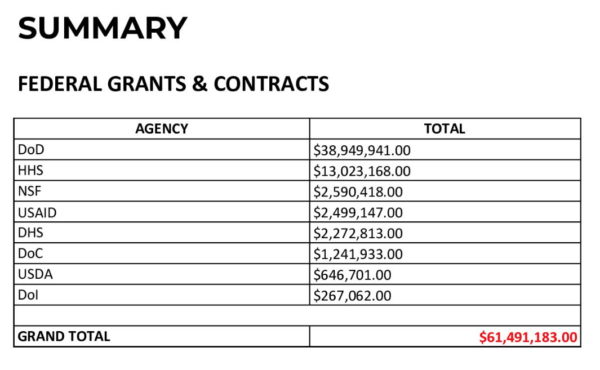
Four significant insights emerge from all this. First, although it is called the EcoHealth Alliance, Peter Daszak and his non-profit work closely with the military. Second, the EcoHealth Alliance attempts to conceal these military connections. Third, through militaristic language and analogies Daszak and his colleagues promote what is often referred to as, and even then somewhat euphemistically, an ongoing agenda known as “securitization“. In this case it is the securitization of infectious diseases and of global public health. That is, they argue that pandemics constitute a vast and existential threat. They minimize the very real risks associated with their work, and sell it as a billion dollar solution. The fourth insight is that Daszak himself, as the Godfather of the Global Virome Project, stands to benefit from the likely outlay of public funds. |

|
A sensor injected under the skin, backed by DARPA, is meant to spot COVID-19 days before symptoms appear
"These sensors make it possible to detect, in 'real time' and over long periods of time, changes in the body's chemistry," Jared Adams, chief of communications for the Defense Advanced Research Projects Agency (DARPA),
The sensor is made up of two parts: a small strip of hydrogel injected under the skin. The strip is tiny, about a 10th of an inch in length. (Hydrogel is same type of material that is used in soft contact lenses.)
Then, outside the skin, there is the detector.
The gel is infused with chemicals. Early markers of infection, such as an abrupt change in oxygen levels, trigger a chemical reaction. The strip starts to glow with fluorescent light, which can be picked up by the detector.
Yahoo
The project has now been passed on from DARPA to the
Joint Program Executive Office for Chemical, Biological, Radiological, and Nuclear Defense
|
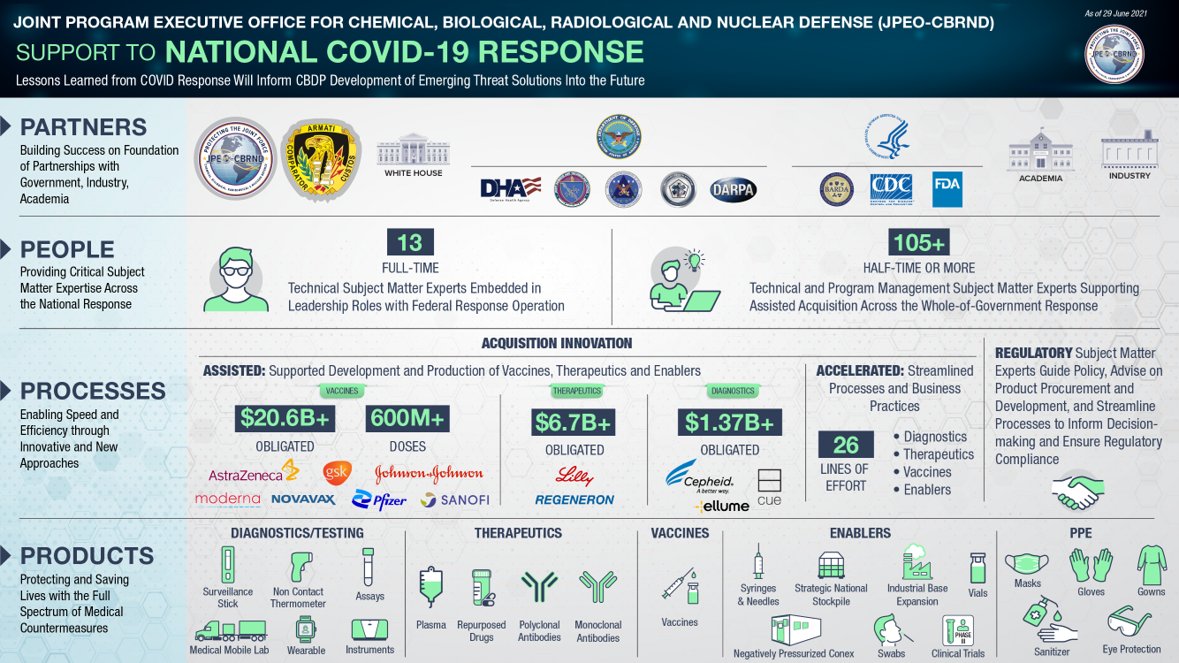
|
How the U.S. government bolstered Moderna’s COVID-19 vaccine candidate
By Brian Buntz | November 23, 2020
Until recently, the most rapidly developed vaccine was for mumps, which took four years. Now, Pfizer (NYSE:PFE) and Moderna (NSDQ:MRNA) appear to be on the cusp of commercializing COVID-19 vaccines under emergency use authorization.
It was only a year ago that physicians in China identified unusual pneumonia cases that would later be associated with the novel coronavirus.
As impressive as the rapid pace of COVID-19 vaccine development has been, researchers have drawn on foundational work that stretches back almost two decades, said Barry Bloom, a research professor at Harvard University, in the recent webinar titled the “Race for the COVID-19 Vaccine: Latest Updates.”
And the Moderna vaccine candidate, in particular, has benefited from U.S. government support.
A marathon as well as a sprint
The race to develop COVID vaccines has roots stretching back to the terrorist attacks on September 11 and the anthrax attacks that followed in the subsequent weeks. The events led the National Academy of Sciences to convene a set of committees to examine the twin threats of terrorism and pandemics. The committees “concluded that we were enormously vulnerable and we had to do a lot of different things [to] protect the country,” said Bloom, who co-chaired a bioterrorism panel for the National Academy of Sciences at the time.
In 2002, severe acute respiratory syndrome (SARS) first appeared in China and took hold internationally within months. Effective public health interventions prevented SARS from becoming a pandemic.
In 2005, the U.S. Department of Health and Human Services (HHS) established the National Pandemic Influenza Plan to provide a blueprint for pandemic response. “At some point in our nation’s future, another virus will emerge with the potential to create a global disease outbreak,” Health and Human Services Secretary Mike Leavitt at the time.
The pandemic plan stressed the importance of antiviral drugs and vaccines. “It is a wonderful plan,” Bloom noted. But before COVID-19 hit, the report had “disappeared in a drawer somewhere in Washington,” he added.
But the U.S. government’s focus on vaccines to combat pandemics likely played a role in spurring further research into novel vaccine platforms.
|
DARPA and BARDA make vaccine investments
Government agencies such as the Defense Advanced Research Projects Agency (DARPA) and the Biomedical Advanced Research and Development Authority (BARDA) would play a role in vaccine development. DARPA “invests in very long term science and technology [projects] that will pay off in 20 years,” Bloom said.
The National Institute of Allergy and Infectious Diseases (NIAID) developed a stabilized SARS-CoV-2 spike immunogen (S-2P) that Moderna would later use in its messenger RNA platform.
DARPA was instrumental in the development of RNA vaccines and provided $25 million in financial support to Moderna in 2013 to pursue messenger RNA–based antibody drugs and vaccines. DARPA announced it was committing up to $56 million in additional funding to Moderna this October.
BARDA has committed another roughly $955 million to Moderna.
In all, the U.S. government vaccine contract with Moderna is worth roughly $1.5 billion. BARDA has also invested in producers of other COVID-19 vaccines.
BARDA was also instrumental in resetting researchers’ expectations for vaccine development, Bloom said. The organization set a goal of developing a vaccine 60 days after determining a pathogen’s DNA sequence. Moderna had a vaccine candidate 66 days after scientists identified its genetic sequence. “And that is a reflection of tremendous foresight by these technical agencies,” Bloom said. By identifying promising research and identifying companies to advance it, the government agencies have played a role in engineering COVID-19 vaccines. But the platform approach could also help fight future pandemics, given its ability to allow researchers to tweak antigens and genes to target a new pathogen.
The U.S. government’s support of the vaccine platform led to investigations into its use to treat infections from Middle East Respiratory Syndrome (MERS), influenza, Zika and HIV. “We had a background on these vaccines,” Bloom said. “The companies were pretty confident they would work [for the novel coronavirus], but it will take [trials] to find out how safe and effective for COVID they really are.”
|
|
|
Who was the Angel Investor? - Who were the following Investors?
When you start researching this you will come across DARPA, LIFElog, CIA.
The Angel Investor for Facebook was Peter Theil. Nearly 5 Lakhs American Dollars was Invested by him in 2004. We should know about Peter Theil. But before that, we should know that When Project Lifelog was shut down, many authors gave their views. They were afraid that DARPA will never easily let go of one of their projects. Their Project will surface in another name.
Peter Theil is a Co-founder of Palantir. It is a Data mining company. So Data Mining needs a lot of data. JP Morgans banks are many. JPMorgan employees were acting against their employer this was a doubt in the minds of the leaders of JP Morgan. So the Leaders of JP Morgan asked for help to a person. That Person was an Ex-CIA officer. His name is Peter Cavicchia. So Peter Cavicchia joins Palantir Technologies and recruits 125 data mining Engineers. Then he runs an algorithm in JP Morgan Chase &Co. After running the algorithm, every employee was given a Cell Phone. This all happened in 2008 to 2009. So the mail sends by any employee should get past the algorithm. The Palantir Algorithm will keep a close watch on the data from the employee’s mobiles. So the Algorithm which was created by Palantir Technologies which was Co-Founded by Peter Theil was the Angel Investor for Facebook.
Now you could have understood the Importance of Data Mining.
SO Govt Organizations like CIA and DARPA need a lot of data. When People started to protest against Project Lifelog, They just changed the name into Facebook. Peter Theil had 10.5% Shares invested in Facebook is the truth which came out in 2004.
The Next Investment for facebook came from Accel Partners. We should know about Jim Breyer who is the CEO of Breyer Capital.
Do you know his friends?
Jim Breyer and his friends are major names in a Not For Profit Venture Capital called In-Q-Tel. In-Q-Tel was created by the CIA in 1999.
|
|
What is the purpose?
This firm monitors the American People’s thoughts, Will they protect against the govt?
What are the people doing?
How to change the people’s thoughts into positive towards the govt?
This is the primary objective of the organization called IN-Q-Tel. Jim Breyer is closely connected to In-Q-Tel. Jim Breyer invests heavily in Facebook.
So the American Govt started an Organization called In-Q-tel and a project called Lifelog. But people started to protest against both. To counter this they introduce Social Media called Facebook.
Mark Zuckerberg maybe the CEO of Facebook.
Who are the investors in Facebook now?
What happens to the data in Facebook?
These are all big unanswered questions. They are already doing data mining. Coming days without data mining nothing will work. If you want to sell your product online you need data mining. If someone wants to know your suggestions on Politics or any other thing, they need data. This data is needed by Govts, Private Sectors, Banks,. They need your data.
You should also now Facebook has all your data. Let’s discuss the Prism Program. Your Social media, Facebook, Google and everything comes under the Project called PRISM. This information is Officially released by the American govt.
So we have discussed Prism, In-Q-Tel, Lifelog Project hiding all in its shadows in Facebook.
What did Facebook do next?
Facebook has now obtained the data. With the current data, they can create Hardware such as Robotics, Superhumans, or maybe Hacking the human brain.
Is Facebook researching it or not?
The answer to this question comes in 2014-15. An Important person speaks in an Important Facebook Event called F8. Her name is Regina Dugan. Regina Dugan once worked for DARPA in a very Higher Position. Regina Dugan comes to work with Facebook. Her project is called Building Eight. So she works for Facebook under the Project called building Eight. She says that they are developing a machine with interconnects a Machine and a Human. She asks for the people’s support.
Building eight project is Developing the Hardware using the data obtained from Facebook. But Suddenly without any announcement, the Project was shutdown.
What could be the reason?
When we go in search of this project. There are so many facts and truth are available.
Is there any more information?
Did Mark Zuckerberg, Lady Gaga, and Google Co-Founder have a meeting somewhere?
Does anyone know about this meeting?
|
|
The Wellcome Sanger Institute
The Wellcome Sanger Institute is one of the premier centres of genomic discovery and understanding in the world. It leads ambitious collaborations across the globe to provide the foundations for further research and transformative healthcare innovations. The Sanger Institute was established in 1993 and sequenced one third of the first human genome in the global Human Genome Project, the single largest contributor and over the last 25 years has pioneered multiple large-scale global projects. It is located at the Wellcome Genome Campus, Cambridge, UK and its success is founded on the expertise and knowledge of its people. The Institute seeks to share openly its discoveries and techniques with the next generation of genomics scientists and researchers worldwide.
The Institute has pioneered responsible clinical genomic data sharing initiatives, such as DECIPHER, which are used daily in clinical genomic testing around the world. The Institute has also catalysed genomic medicine through landmark translational research projects such as the DDD and PAGE studies, which were co-funded by DHSC and laid the foundations for the 100,000 Genomes Project.
from the UK Gov report -
The future of Healthcare
|
|
Watch as Regina Dugan talks of the 1st 1000 days health monitoring infants from birth - promoting tools for nutrition & brain development.
|
In this episode of Harman’s interview series “The Next Wave,” Young Sohn talks with Dr. Regina Dugan on innovation, leadership, and making a lasting impact.
Regina has led diverse efforts that have ranged from key defense and industry projects as the first female director of DARPA, including her early involvement in the technologies behind the present-day mRNA Covid-19 vaccines, and at a very personal level, her battle with childhood cancer that shaped her approach to life and leadership, including her decision to accept the role of CEO of Wellcome Leap, an organization devoted to creating more breakthroughs in human health.
Wellcome Leap is targeting a host of complex human health challenges with the goal of achieving new scientific and technological solutions in the span of a decade. Wellcome Leap is powering innovations for global health by taking on bold, unconventional programs and funding them at scale. One of Leap’s new programs is called the First 1000 Days. Its premise is that we need objective, scalable ways to assess a child’s? cognitive health, especially during the first 1000 days of life—just as we routinely measure height and weight to assess a child’s physical health. -
|
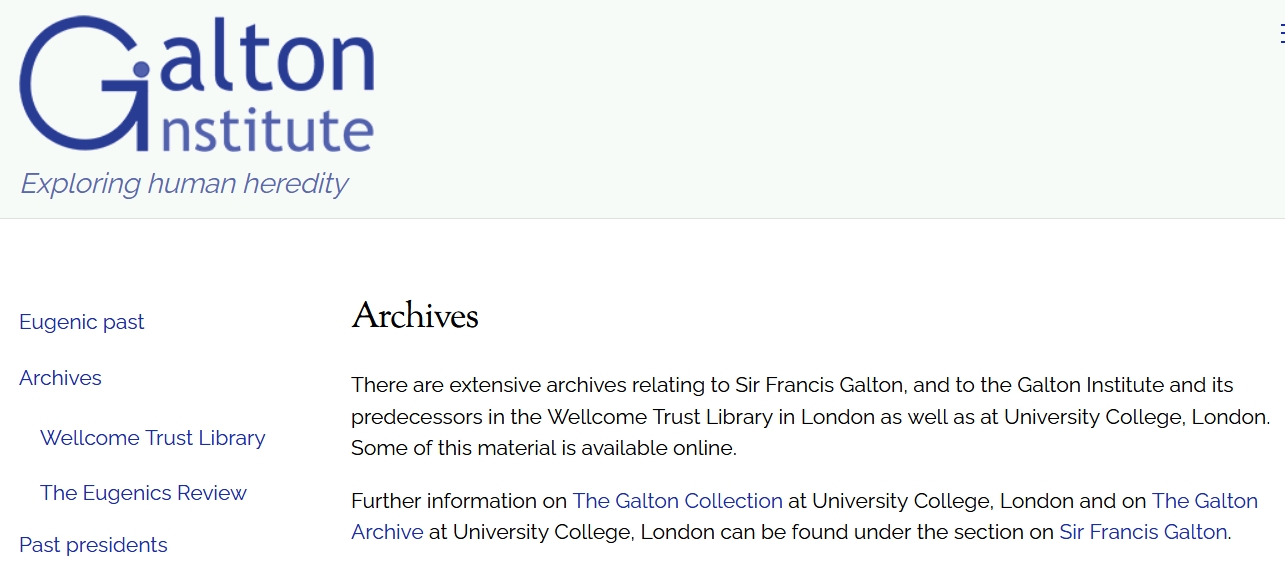 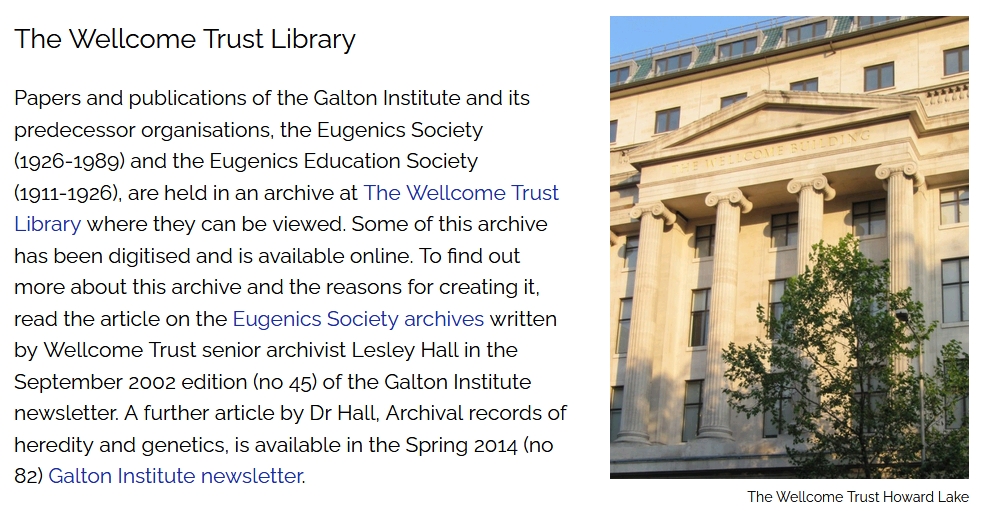 |
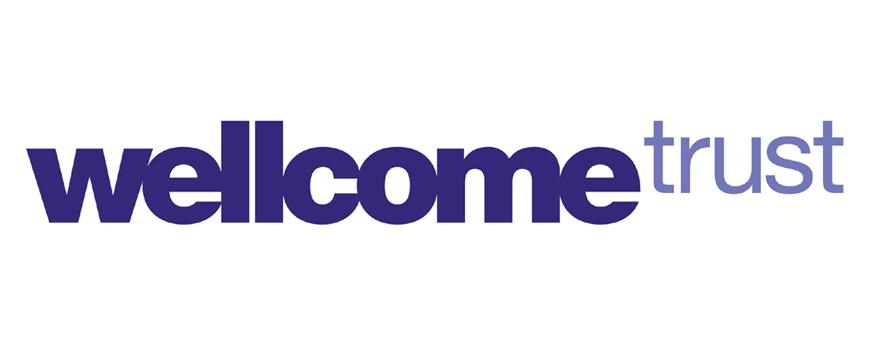 
|
|
Wellcome Leap - Biotech
Wellcome Leap nabs $300M, ex-DARPA, Illumina execs to battle global health problems
The U.K.'s Wellcome Trust has spun out a new nonprofit with a hefty seed fund and some big names to battle against the most pressing global health challenges of our time.
It starts life with $300 million in funding with former U.S. Defense Advanced Research Projects Agency (DARPA) Director Regina Dugan coming on board as its lead and former Illumina CEO Jay Flatley talking the chairman's role.
Leap will undertake bold, unconventional programs and fund them at scale," it says in a statement, and comes amid the COVID-19 pandemic, which it says has and should change the way we think about how to tackle healthcare issues, and what should be prioritized.
Two years in the making, Leap will recruit program directors to build and work on programs that identify opportunities and gaps, and plug those gaps with science and engineering from diverse disciplines.
It will bring together and stump up cash for teams of scientists and engineers drawn from universities, nonprofits, and the commercial sector. Operations at Leap will use accelerated timelines beginning with abstract and proposal evaluations that take weeks rather than months, it said.
Leap is not, however, in the business of building permanent labs, and program directors will be appointed for specific, discrete, time-bound projects, and isn't looking to take a cut of sales from any therapies it makes.
CEO Dugan said: The global pandemic is our generation's Sputnik. It is calling on us to respond urgently'”now'”and also to create new capabilities for the future. We need new, risk-tolerant innovation organizations to drive health advances at the pace the world needs them, not only for the current crisis, but for the most pressing global health challenges of our time. I am excited to lead Leap.
In the fight against COVID-19, scientific organizations are dispensing with old conventions and assumptions to stretch the limit of what's possible. The world needs an entity dedicated to operating that way at all times, added Flatley. Leap will pursue the most challenging projects that would not otherwise be attempted or funded. The unique operating model provides the potential to make impactful, rapid advances on the future of health.
The new organization will be independent from Wellcome and governed autonomously to encourage speed, agility, and an appetite for risk-taking, the new group said.
|
|
Changing organs that produce Bio chemicals that enable human transformation
We need better models of human physiology – |
|
|
Monitoring infants Brains then changing them to suit their agenda...
"We routinely measure height and weight
|
|
|
"we’ll be able to intervene in diseases earlier and with approaches that are targeted to the individual. We’ll also have an improved understanding of the mechanisms that drive disease, which, in turn, will provide more opportunities for intervention"
|
|
|
Behavior modification for a robotic slave hive minded army
"
We understand that synaptic connections serve as the currency of neural communication, and that strengthening or weakening these connections can facilitate learning new behavioral strategies and ways of looking at the world. Through studies in both animal models and humans, we have discovered that emotional states are encoded in complex neural network activity patterns, and that directly changing these patterns via brain stimulation can shift mood. We also know that disruption of these delicately
balanced networks can lead to neuropsychiatric illness."
|
|

Microsoft, Google invest in genomics platform firm DNAnexus
by Angus Liu | Jan 3, 2018 9:15am
DNA Foresite Capital, Microsoft, GV and others invested $58 million in genomics firm DNAnexus.
Biopharma companies, medical research institutions and healthcare facilities have growing interest in getting more genomics data, and that has translated into new investments. A $58 million financing round DNAnexus completed is just one recent example.
The round was led by healthcare-focused investment firm Foresite Capital, with strategic investment from Microsoft. Alphabet's investment arm GV (formerly Google Ventures) and Wuxi AppTec's genomics subsidiary WuXi NextCODE are among existing investors that also participated.
The California company's cloud-based platform enables sharing, management and analysis of huge volumes of genomic data to help researchers collaborate on R&D projects.
As the volume of biomedical information continues to increase, the DNAnexus platform and upcoming product releases catalyze collaboration, data sharing and machine learning on which the development of precision medicine depends, Foresite founder and CEO Jim Tananbaum said in a statement.
To DNAnexus CEO Richard Daly, such cross-institutional collaborations are crucial in creating multi-omics data that aid biomedical insights. The $58 million'”a large infusion compared with the $15 million it raised back in 2014 and another $15 million it got from WuXi in 2015'”will be used on further development and launch of its translational medicine solutions, as well as expanding the reach of its platform in clinical trials, said Daly.
DNAnexus has made quite a few high-profile expansions in the drug R&D market in 2017.
Its platform was chosen by AstraZeneca's Centre for Genomics Research, a project launched in 2016 through a partnership with Craig Venter's Human Longevity, to analyze over two million genomes in a decade to inform drug discovery and development.
In June, it launched a new microbiome platform called Mosaic in collaboration with Janssen Research & Development. The idea is quite the same, that scientists could store and manage microbiome data securely and collaborate easily.
A few weeks ago, DNAnexus started incorporating Google's new DeepVariant bioinformatics technology on its platform. The Google-developed tool uses deep learning to call genetic variants from next-generation sequencing data.
DeepVariant is one of the first tools to deliver on that promise by making the critical first step to more accurately identify genetic differences among individuals, Vik Bajaj, Foresite's managing director and former CSO at Verily Life Sciences, said in a statement back then. By making a reference implementation broadly accessible, I believe Google and DNAnexus will accelerate a growing body of research that requires high-quality genomic information"
Fierce Biotech
RELATED: AstraZeneca teams with Venter to mine genomes for R&D insights
|
.svg.png)
AZ was part of huge chemical company - ICI
IMPERIAL
In 1993 the British chemicals company ICI demerged its pharmaceuticals / agrochemicals and specialities businesses, to form Zeneca Group PLC. 1999 Astra and Zeneca Group merged into AstraZeneca plc, with its headquarters in London.
|
22 April 2016
AstraZeneca and its global biologics research and development arm, MedImmune, today announced an integrated genomics initiative to transform drug discovery and development across its entire research and development pipeline.
The initiative includes new collaborations with
Human Longevity, Inc., US;
the Wellcome Trust Sanger Institute, UK,
and The Institute for Molecular Medicine, Finland.
AstraZeneca will also establish an in-house Centre for Genomics Research which will develop a bespoke database comprising genome sequences from samples donated by patients in its clinical trials together with associated clinical and drug response data.
AstraZeneca believes that embedding genomics across its research and development platforms will:
deliver novel insights into the biology of diseases;
enable the identification of new targets for medicines;
support selection of patients for clinical trials;
allow patients to be matched with treatments more likely to benefit them.
|
|
Menelas Pangalos, Executive Vice President, Innovative Medicines & Early Development at AstraZeneca said: Using the power of genomics is the foundation of our ambition to develop the most innovative and impactful treatments for patients. With the advent of next generation sequencing and the increased sophistication of data analysis, the time is now right to immerse ourselves fully in the international genomics community through these pioneering collaborations and through the creation of our own genome centre. We will leverage information from up to 2 million genome sequences, including over 500,000 from our own clinical trials, to drive drug discovery and development across all our therapeutic areas. Genomics will be fundamental to our laboratory research, our clinical trials and the launch of our medicines for patients.
Human Longevity, Inc, US.
AstraZeneca aims to share up to 500,000 DNA samples with Human Longevity, Inc, from which Human Longevity will sequence full genomes and deploy its state-of-the-art machine learning, pattern recognition and other analytical techniques. These genomic samples will include those donated by patients under optional informed consent in AstraZeneca's clinical trials. AstraZeneca will also gain access to Human Longevity's unique database of up to 1 million integrated genomic and health records to add to its analysis.
AstraZeneca's Centre for Genomics Research
AstraZeneca is creating an in-house Centre for Genomics Research focused on the creation and use of a bespoke database of genome sequences from samples donated by patients in its clinical trials over the past 15 and over the next 10 years, integrated with associated clinical and drug response data. In addition, the Centre will access up to 500,000 genomes available through AstraZeneca's collaborations and from the public domain. The Centre will be located in AstraZeneca's corporate headquarters in Cambridge and work closely with the international genomics community to derive broad scientific and clinical benefit from these unprecedented genomic resources.
The Wellcome Trust Sanger Institute, Cambridge, UK
AstraZeneca will establish a research team led by a genomics expert of international reputation, embedded within The Wellcome Trust Sanger Institute's world-renowned Genome Centre in Cambridge, UK. AstraZeneca will share genomic samples and associated clinical data, plus its drug development expertise across core therapy areas. The two parties will identify new targets and biomarkers with potential use in diagnostic tests.
The Institute for Molecular Medicine Finland (FIMM), University of Helsinki, Finland
AstraZeneca will collaborate with The Institute for Molecular Medicine, Finland and its partners in Finland and the US, to study genes of interest in the Finnish population, which is known to carry a higher than normal frequency of rare variants. Additionally, Finland has an integrated health record system supported by a national biobanking law that facilitates recall of volunteers for thorough clinical evaluation.
Bahija Jallal, Executive Vice President, MedImmune, said: The fields of genetics and genomics evolve so rapidly that no single company can internalise this type of research and do it all themselves. We are acutely aware of this, which is why we have chosen to work with the genomics community to leverage external expertise in genomic analyses and the design of large-scale genetic studies. Together, with the rich clinical data from our biobank, we will translate these findings into better understanding of disease and ultimately, more effective treatments for patients.
In line with AstraZeneca's open innovation approach to research and development, research findings from all collaborations across its genomic platform will be published in peer-reviewed journals, contributing to the broader scientific understanding of the genetic influence of disease and positioning AstraZeneca as a key player in the global genomics research community.
|
|
|
Multiple countries have paused the use of AstraZeneca's COVID-19 vaccine as a precaution while investigators look into cases of blood clots among vaccinated people.
Austrian authorities said March 7 that a 49-year-old woman had died as a result of severe coagulation disorder after taking the shot, and that a 35-year-old had developed blood clots in the lungs, but was recovering. Both had received vaccines from the same batch, the authorities said.
|
|
|
Sarah Gilbert & Vaccitech
a co-founder of the University's Oxford spin in-out company Vaccitech, which is developing novel vaccines using the non-replicating viral vectors Chimpanzee Adenovirus Oxford (ChAdOx) and Modified Vaccinia Ankara (MVA).
The Jenner Institute
note Pirbright logo
Porton Down corporate shoot offs...
include QinetiQ
PORTON DOWN IS OF ROYAL [IMPERIAL] ASSENT
|
|
Vaccitech
The platform was licensed from the prestigious Jenner Institute for vaccine research at the University of Oxford, which dedicated over 20 years of research to identify and refine the optimal method for CD8+ T cell induction in humans. This platform has generated a robust, largely immunotherapeutic pipeline of six clinical product candidates for infectious disease and cancer indications, four of which are in co-development with partners and external funding.
Vaccitech is backed by leading investment institutions, including M&G, Tencent, Gilead Sciences, GV (formerly Google Ventures), Sequoia Capital China, Liontrust (formerly Neptune), Korea Investment Partners and Oxford Sciences Innovation.
|
The Pirbright Institute
'Preventing and controlling viral diseases'
We are a world leading centre of excellence in research and surveillance of virus diseases of farm animals and viruses that spread from animals to humans. We receive strategic funding from the Biotechnology and Biological Sciences Research Council (BBSRC), and work to enhance capability to contain, control and eliminate these economically and medically important diseases through highly innovative fundamental and applied bioscience.
The Institute employs around 350 staff, research students and visiting scientists, and has recently moved to one campus in Pirbright, Surrey, where investment by BBSRC has resulted in a redevelopment of the site and the construction of a high level containment facility –
the BBSRC National Virology Centre:
The Plowright Building and a
SAPO level two facility, The Jenner Building.
see also this; WakeUpWiki report
one of many Patents filed by the Pirbright institute...and the appprox 4,593 patents filed for Aquired Respitory Syndromes under A61K39%2f215
Many Thanks to Francis Leader for providing information
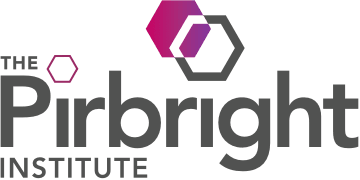
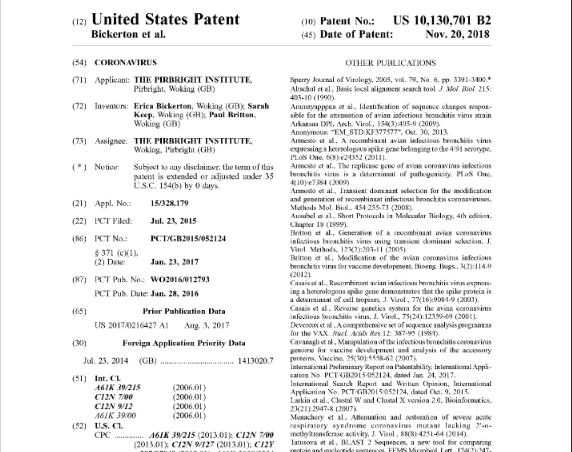
"
The present invention provides a live, attenuated coronavirus comprising a variant replicase gene encoding polyproteins comprising a mutation in one or more of non-structural protein(s) (nsp)-10, nsp-14, nsp-15 or nsp-16. The coronavirus may be used as a vaccine for treating and/or preventing a disease, such as infectious bronchitis, in a subject."
both the following are corporate institutions
QinetiQ
note; Battlespace is considered cities
born from Defense establishments, who authorised this?
 |
Porton Bio Pharma [ex-Porton Down bioweapons Defense Laboratory]
Porton Biopharma is based at Porton Down near Salisbury in Wiltshire. There is a long history of pharmaceutical development and manufacturing at the Porton Down site. Both Erwinase® and Anthrax Vaccine were developed here, as well as many other products (such as Dysport® and Voraxase® which have subsequently been out-licensed to other companies). The Porton Down site was originally under the single ownership of the UK military. In 1979, the site was split, with our part of it transferring in to the health sphere as the Centre for Applied Microbiology & Research (CAMR) and operated as part of the Public Health Laboratory Service. Ownership of CAMR was transferred to the Microbiological Research Authority, a Special Health Authority in 1994 where it operated until 2003, when it became part of the Health Protection Agency (HPA). PORTON BIO PHARMA |
|
The top secret military lab trying to find a coronavirus vaccine
[excerpt] What is Porton Down? Where is it? Porton Down is a 'science park' located in Wiltshire, just northeast of the village of Porton, near Salisbury. Northwest of it lies the MOD Boscombe Down airfield operated by defence technology company QinetiQ, the world's 52nd largest defence contractor and sixth largest in the UK. Founded in 1916, Porton Down is home to the oldest chemical warfare research installation in the world and two British government facilities - a site of the Ministry of Defence's Defence Science and Technology Laboratory (Dstl) and a site of Public Health England, from whom we have been getting our daily coronavirus figures. In addition to this, Porton Down is also home to other private and commercial science organisations and is ever expanding to attract other companies. On some maps, the land surrounding the complex is identified as a "Danger Area". What do they do there? It opened in 1916 as the War Department Experimental Station, later renamed the Royal Engineers Experimental Station, for testing chemical weapons in response to German use of this type of war a year earlier. The laboratory's remit was to conduct research and development regarding chemical weapons used by the British armed forces in WW1, such as chlorine, mustard gas and phosgene. In 1929 the Royal Engineers Experimental Station became the Chemical Warfare Experimental Station (CWES) and in 1930 the Chemical Defence Experimental Station (CDES). By 1938 they concentrated on offensive chemical warfare research and development and, during WWII, were focusing their research on chemical weapons like nitrogen mustard and later highly toxic organophosphorous nerve agents such as sarin. To examine biological weapons, a highly secret separate department, called the Biology Department, Porton (BDP) was established within the Chemical Defence Experimental Station in 1940, with its focus on anthrax and botulinum toxin and in 1942 it famously carried out tests of an anthrax bio-weapon at Gruinard Island. This department (later called the Microbiological Research Establishment/MRE) occasionally collaborated with the Common Cold Unit at Harvard Hospital, Harnham Down, on the west side of Salisbury. |
|
Imperial Oxford president - Alice Gast admits RNA technology is Synthetic Biology.
Alice Gast speaks; Technology Governance Outlook @41 mins
"The Pandemic has made it obvious to us that Viruses are a risk. They don't know boundaries so the importance of the inclusion of this colloboration is stark.
The also show you the really fantastic advances of science and basically science going on for a decade that led to the rapid ability to create new vaccines with unprecesdented speed.
And synthetic biology is a really interesting topic because it is a means of creating new molcules and new life...& unlike chemistry, it is built through biological processes rather than chemical reactions.
Perhaps there is no better example of synthetic biology than the RNA Vaccines that we're benefitting from today. So there you have the great benefits or the great risks of biology working for you or going wrong."
|
IMPERIAL Collage Oxford @ The WEF 2019
Alice Gast President of Imperial Oxford college
introduces the MRNA technology
Davos participants will get the chance to hear from Imperial College experts Wendy Barclay, Robin Shattock and Jason Hallett who are working to reverse the inverse care law as they advance vaccine technology, helping it to leapfrog existing options. Their work enables unprecedentedly rapid production of new vaccine doses, within weeks of a disease threat being identified. Their teams are also developing new room-temperature storage options that could eliminate the use of cold chains: a major hindrance to storing vaccines in low-income countries. Professor Barclay is even working to stop diseases like influenza spreading without the need for vaccines.
World Economic Forum
President Gast also chaired the Global University Leaders Forum (GULF)
and spoke on a panel with President of Colombia Iván Duque Márquez
and global CEOs, including Marc Benioff of Salesforce to update on the
Centres for the Fourth Industrial Revolution Network.
|
|
UK Imperial Oxford at the WEF 2019
Three Imperial scientists presented their ideas on next generation vaccines to global leaders at the World Economic Forum in Davos, Switzerland.
The academics from Imperial's Network for Vaccine Research, joined leaders from the G20 and other countries, CEOs of multinationals, members of international organisations and other scientists at the WEF Annual Meeting.
The Imperial group lead an IdeasLab session titled '˜Developing a Vaccine Revolution'.
|
Imperial Network for Vaccine Research
FUNDING From
BMGF Bill and Melinda Gates Foundation
https://www.imperial.ac.uk/vaccine-research-network
|
|
Headline initiative: UK Biobank
UK Biobank is a national and international resource for health research providing unparalleled opportunities for understanding the determinants of disease. The resource offers non-preferential access to researchers undertaking health-related research that is for the public good. UK Biobank aims to improve the prevention, diagnosis and treatment of a wide range of serious and life-threatening illnesses.
Following the health and well-being of its 500,000 volunteer participants, UK Biobank provides detailed health information, in a manner which does not identify them, to approved researchers in the UK and overseas, from academia and industry. The resource is increasingly detailed and is already the most genetically characterised medical research resource in the world.
Funded primarily by the MRC and the Wellcome Trust, UK Biobank recruited people aged between 40 and 69 years in the years 2006 to 2010 from across the country to take part in the project. They have undergone measures, provided blood, urine and saliva samples for future analysis, given detailed information about themselves and agreed to have their health followed. More recently, UK Biobank has embarked on a project to Magnetic Resonance Image (MRI) key organs of 100,000 participants and has previously undertaken biochemistry and genetic analysis of samples.
In September 2019, a £200 million investment from government, industry and charity was announced to further cement UK Biobank's reputation as a worldleading health resource. The investment secures the WGS of all UK Biobank participants.
The addition of the whole genome sequence data from all 500,000 participants will dramatically enhance the ability of the resource to support innovative and imaginative research. It will enhance the ability of scientists to understand how genetics combine with lifestyle and the environment in which we live to cause disease.
At the time of publication, UK Biobank has approved over 12,000 registrations from researchers working in over 1,500 institutes in 68 countries, and has approved over 1,500 applications to enable these researchers to access this valuable resource. To date, more than 900 journal articles using UK Biobank data have been published.
All bona fide researchers from the UK and overseas and from academia, government, charity and commercial companies can apply to use the resource by following UK Biobank's access procedures.
UK Biobank measurements
While taking in socio-demographics and lifestyle factors, the UK Biobank conducts the following measurements:
cognitive tests
All these measurements are linked to:
electronic health records
from the UK Gov report -
The future of Healthcare
|
|
|
European Bioinformatics Institute
In 1992, the European Molecular Biology Laboratory (EMBL) voted to establish the EMBL-European Bioinformatics Institute (EMBL-EBI) and locate it on the Wellcome Genome Campus in Hinxton, UK, where it would be in close proximity to the major sequencing efforts at the Wellcome Sanger Institute. The EMBL is an international governmental organisation, of which the UK is a member.
EMBL-EBI develops databases, tools and software that make it possible to align, verify and visualise the diverse data produced in publicly-funded research, and make that information freely available to all. They collaborate with scientists and engineers all over the world, and provide the infrastructure needed to share data openly in the life sciences.
Genomics in practice: Rare Diseases Sprint Exemplar Innovation Project
from the UK Gov report -
The future of Healthcare
|
|
The NIHR Bioresource Rare Diseases Sprint Exemplar Innovation Project
aims to develop a secure cloud research platform with the potential to transform the understanding of rare genetic disorders, drive improvements in diagnosis, and provide proof of principle for use in other diseases.
The collaboration will build on the advances that clinical imaging, pathology, and genomic technologies have made in understanding rare diseases by creating a secure, anonymised platform to draw together and integrate data from the NHS with research data. The project team worked with patients from 3 rare disease cohorts enrolled in the NIHR BioResource, enabling de-identified phenotype and genotype data to be integrated and made available for approved research studies.
This model is now being developed and scaled in other disease areas. The long-term goal is to use this model to provide a world-class, multi-dimensional integrated data resource for research and innovation that is based on open data standards, protects the privacy of participants, and can be readily scaled and replicated for other disease areas.
The NIHR BioResource
The NIHR BioResource for Translational Research in Common and Rare Diseases (NIHR BioResource) is a national resource of around 100,000 volunteers who have consented to be recalled for research based on their genotype and/or phenotype. This includes around 70,000 participants from the general population, almost 20,000 participants with rare diseases, and more than 28,000 patients with inflammatory bowel disease.
The NIHR BioResource provides researchers from academia and industry with unprecedented access to highly characterised patients with common and rare diseases and volunteers from the general population diseases who are interested in participating in early translational research. The Bioresource is a unique resource that is recognised as a rapid and highly efficient mechanism for recruitment to clinical trials and studies by:
enabling the identification of highly characterised individuals and cohorts of patients who have volunteered to be recalled for research
facilitating seamless, one-stage central identification and recall of volunteers who meet precise entry criteria for clinical research studies
supporting recruitment to clinical trials that could not be delivered without access to stratified national patient cohorts
The BioResource has supported over 200 studies involving recall of participants to research studies.
NIHR Biomedical Research Centres
The NIHR funds 20 Biomedical Research Centres (BRCs) created to support the transfer of new scientific discoveries into early translational and clinical research. The BRCs are partnerships between English NHS organisations and universities, bringing together academics and clinicians to translate discoveries from basic science through into potential new treatments, diagnostics and medical technologies.
BRC funding supports researchers of the highest calibre to develop innovative research ideas that can attract investment from other funders, furthering the nation's economic growth.
The BRCs provide a focus for experimental medicine and undertake research on a wide range of disease and therapeutic areas and more than half of the BRCs have research themes which include genetics and genomics research. The BRCs also work together as part of the NIHR BioResource for Translational Research in Common and Rare Diseases
from the UK Gov report -
The future of Healthcare
|
|
The Global Alliance for Genomics and Health
Data standards enable the effective, responsible, and secure sharing of genomic and health-related data and play a vital role in strengthening national and international collaboration.
The Global Alliance for Genomics and Health (GA4GH) is a coalition of over 500 organisations worldwide working together to establish frameworks and standards for responsible, voluntary and secure sharing of international genomic and health-related data. The ultimate goal is to advance healthcare and enable benefits to biomedical research through facilitation and implementation of agreed international standards. The consortium advocates for responsible data sharing and produces the necessary practical standards.
The GA4GH has been working on a number of specifications related to genomic data that can contribute to these capabilities across its various work streams steered by the relevant Driver Projects. GA4GH Driver Projects are realworld genomic data initiatives that help guide the development efforts and pilot the tools designed for and by the Driver Projects.
Machine learning and artificial intelligence
Machine learning is already being used within Genomics England to automate genome quality control. Using machine learning it has been possible to identify genomes that are outliers, based on their sequencing or sample characteristics. Machine learning has improved the ability to process genomes rapidly and to high standards and soon will help improve genome interpretation.
The research community has also started using various types of AI based methods to derive insights from the UK Biobank data and within the Genomics England research environment. For example, researchers are using such methods for identifying genetic mutation signatures associated with certain cancers, helping to identify and classify sub-types of the disease and find targets for new treatments. This has the potential to improve cancer diagnosis by making more accurate predictions of disease progression, and to better stratify patients for more effective and efficient treatment. Similar work is ongoing with rare disease, to identify driver mutations of particular conditions. These and other AI models will be able to better predict the severity of outcomes based on genomic and clinical data.
The genomic revolution can only be realised with a smart, modern approach to data and informatics. We want the UK to be the home of genomic-enabled research, and simple, secure access to high quality data is a critical component. We want the UK to be the home of genomic-enabled research, and simple, secure access to high quality data is a critical component.
At the same time, there is a unique data sharing challenge within the four nations, and it is currently difficult to compare and share data across borders. This benefits no-one, and we commit to working in partnership across the administrations to realise effective data sharing.
To achieve, maintain and measure success over the next 10 years we will:
through the use of machine learning and AI, understand how genomically informed healthcare and prevention could be improved and how these could be implemented in the NHS, embedding potentially lifesaving technologies quickly and efficiently in the NHS
establish a clear set of standards for genomic and health data
develop systems to enable federated access to data for research use to enable comparisons across multiple datasets
track the usage of our datasets and maintain an upward trajectory of both numbers and user experience
learn from the growing number of AI based businesses in the UK on how to turn these applications into healthcare interventions
from the UK Gov report -
The future of Healthcare
|
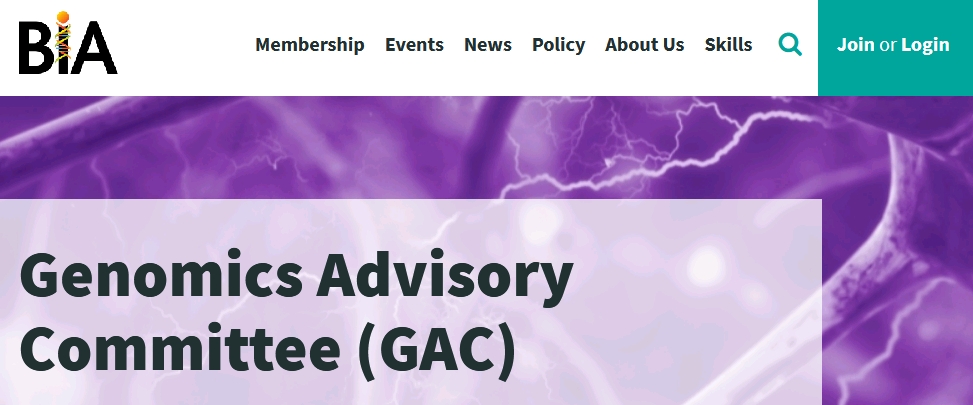
|
UK genomics advisory committee
The BIA's Genomics Advisory Committee (GAC) ensures that the UK starts, scales and builds world leading genomic businesses. The Committee acts as a leadership platform for sharing and discussing issues of common concern between genomic businesses and provides expert advice to the BIA to collectively input to relevant policy discussions, especially with the UK government. Committee membership is open to BIA member companies working in -omics.
|
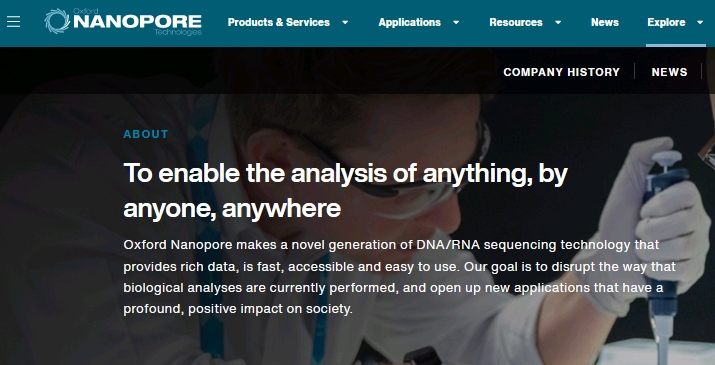
|
Our goal is to enable the analysis of anything, by anyone, anywhere.
Oxford Nanopore makes a novel generation of DNA/RNA sequencing technology that provides rich data, is fast, accessible and easy to use.
Our goal is to disrupt the way that biological analyses are currently performed, and open up new applications that have a profound, positive impact on society.
|
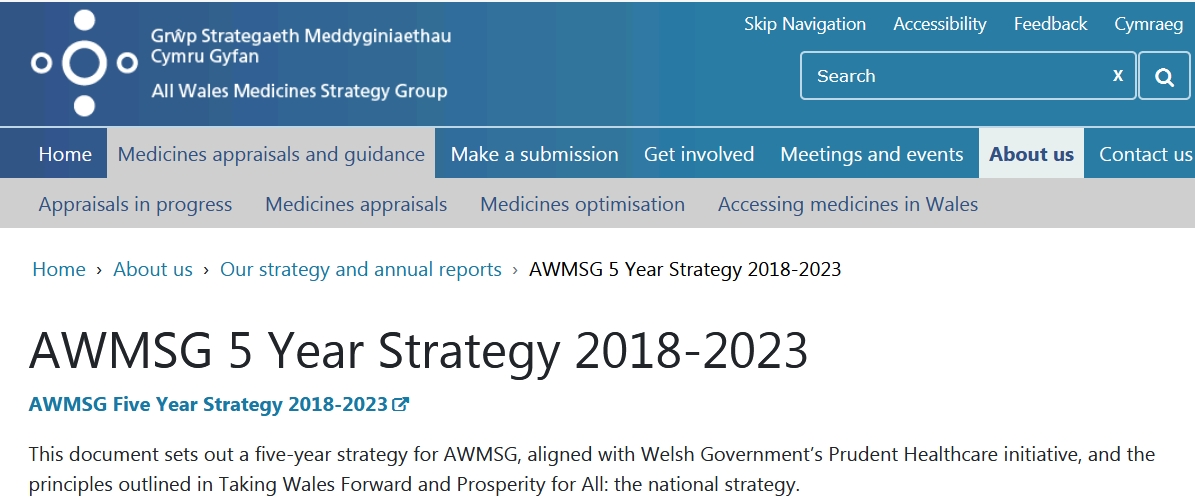
|
All Wales Medicines Strategy Group
AWMSG Five Year Strategy 2018-2023
This document sets out a five-year strategy for AWMSG, aligned with Welsh Government’s Prudent Healthcare initiative, and the principles outlined in Taking Wales Forward and Prosperity for All: the national strategy.
The principles of Prudent Healthcare will only be achieved by working in partnership with many organisations to deliver a medicines strategy in Wales that promotes safe and effective prescribing practice. The recommendations made in this strategy are aligned to these principles to ensure healthcare fits the needs and circumstances of patients and avoids wasteful care.
|
|
Michael Clarke, visiting professor in war studies at Kings College London (KCL), warned how countries could be using DNA as a farmer would in a herd of cattle.
He told The Sun Online: “We’ve reached the point now where we could potentially manipulate people’s DNA to breed into them extra strength, endurance and other things just as we do with animals.
“Just as we’ve done with standard cattle to give them more back, we can do that now very precisely with humans.”
And Prof Clarke, a former specialist advisor to the House of Commons Defence Committee, said this is fuelling the biological race, with countries fearing what China may be able to produce in the near future.
He said: “What they’re all thinking about is what might come up in 30 years’ time, given another 10 years development and experimentation.
“The Chinese in 30 years’ time might have a cohort of people who are 20 years-old who’ve got particular characteristics they might have tried to breed into them by manipulating DNA."
|
Superhero vaccine will give body-wide genetic upgrade, says Stanford scientist
'˜Superhero' vaccine based on Olympic athlete DNA could provide '˜body-wide genetic upgrade'
June 26, 2021
by Study Finds
Stanford prof says treatment would offer long-term protection against heart disease, Alzheimer's, and other health conditions.
STANFORD, Calif. '” A groundbreaking superhero vaccine inspired by the DNA code of Olympic athletes could help transform society over the next decade, a top genetic scientist claims.
The vaccine would provide lifelong protection against three of the top ten leading causes of death, according to Euan Ashley, professor of medicine and genetics at Stanford University. The so-called superhero jab could offer simultaneous, long-term protection against heart disease, stroke, Alzheimer's disease, and liver disease, thanks to advances in genetic engineering.
This breakthrough treatment would deliver the blueprint of ideal cells from men and women whose genes are more disease-resistant than those of the average person, together with an instruction manual to help the body repair, tweak and improve its own versions. A single dose could lead to a body-wide genetic upgrade that would cut the risk of premature death in some adults by as much as 50 percent.
When would a '˜superhero' vaccine become available?
Ashley says the vaccine would be administered to those in serious clinical need before being rolled out to the wider population, including children. Clinical trials of individual components are expected to begin by 2026, with the combination vaccine to become available within 10 to 15 years.
If breakthroughs in genome research and technology continue to evolve at the same rapid pace, the vaccine could be widely available worldwide in just 10 years, according to Ashley, who is also the associate dean at Stanford University. Prof. Ashley, 49, is the founding director of Stanford's Center for Inherited Cardiovascular Disease and its Clinical Genomics Program.
Genomic medicine has been promised for decades, but thanks to advances in the field we are now reaching the stage where that promise is set to become reality, ushering in a bold new era of medical treatments, the professor says in a statement to SWNS.
We will soon have the genetic engineering tools to repair, tweak and improve DNA associated with a host of life-limiting diseases, to make us all less prone to developing these illnesses across our lifetimes. This isn't, of course, to say that we can make people live forever, and we can't guarantee life expectancy will increase, but it is likely premature deaths could be avoided in many cases, Ashley continues.
Advances in DNA modification mean the number of people with '˜superhuman' genes'”those who are more disease resistant'”is no longer science fiction but, in the coming years, absolute science fact. Potentially millions of people could be impacted by this technology - a superhero jab, for want of a better description.
|
|
This has the potential to greatly reduce the burden of diseases with a genetic component such as Alzheimer's disease, liver disease, coronary heart disease and associated conditions such as strokes, and vascular dementia, the Stanford geneticist goes on to say. It is not only possible, but probable, that such a jab will become available in the next 10 to 15 years, with the benefits of that treatment becoming apparent within the next two to three decades. If we modelled on fatal heart attacks alone then the new treatment could lead to as much as a 50 per cent reduction in incidence.
An '˜autocorrect' vaccine for your genes
Traditional vaccines work by teaching the immune system to recognize a foe by delivering a dead or weakened pathogen into the body. This triggers the immune system's own antibodies to seek out the pathogens and the foreign proteins they carry and destroy them.
However, most genomic vaccines, including the proposed superhero shot, work by delivering strings of genetic code to certain cells. This code includes multiple versions of a gene editor, a tool like a word processor, which alters just one letter of DNA from a disease-prone version to a disease-resistant version.
To ensure that the gene editors reach the right organs safely and are not destroyed on the way to the body's immune system, they are carried by inactivated targeting viruses or encased in lipids (fat particles) to the precise destination. The lipid technique is used by Pfizer-BioNTech to package its COVID-19 vaccine.
Scientists liken gene editing to the autocorrect feature used to correct spelling mistakes in documents written on a computer. Instead of rewriting words however, gene editing rewrites corrupt DNA. The technique is not new, but remains relatively untested, at least in humans.
Prof. Ashley says ongoing advances in the genome editing tool CRISPR (clustered regularly interspaced short palindromic repeats) will lead to very significant developments in the treatment of serious disease within the next decade. They are already considered to be easier and cheaper to make at scale.
Gene editing is now coming of age, bringing with it the exciting possibility of preventing serious diseases in the population before they develop, Prof. Ashley adds. Not everyone will be susceptible to these diseases but, for those who are, this will be a revolutionary new approach to preventing disease.
There is still much to do, not least in terms of ensuring the medicine is safe, and nothing in genetic medicine is ever guaranteed, but as it now stands it looks likely that we may be able to avert a large number of heart attacks and strokes and perhaps many other diseases to keep people healthy and happy for longer.
Real-life superhumans already exist
The likelihood of a superhero vaccine relies on finding real-life superhumans whose genes are uniquely resistant to disease, or those more capable of fighting them. An example is the Finnish Olympian Eero Mäntyranta, who was found to have an unusually high level of hemoglobin, indicating an excess of oxygen-carrying red blood cells, which boosted his endurance levels.
Other examples include American Sharlayne Tracy, who was found to have unusually low cholesterol levels, and an unnamed Pakistani boy who could not feel pain. The exact number of people with superhuman genes remains unclear, but is thought to include several million people worldwide.
Prof. Ashley believes genetic databases such as the UK BioBank, which currently holds health and genetic information on more than 500,000 people, will play a crucial part in genetic vaccine development. They have already uncovered superhuman genes for heart disease, liver disease, and Alzheimer's disease, and could hold the key to cancer prevention and other terminal diseases in the future.
Report by SWNS writer Ollie Buckley, phots provided by SWNS.
https://www.walesonline.co.uk/news/uk-news/superhero-vaccine-give-body-wide-20892477
https://www.studyfinds.org/superhero-vaccine-euan-ashley-stanford/
|
|
|
2.3 Concept
To participate in society, regardless of age, culture, physical ability, time or distance it is important for people to enhance their autonomous and interactive activities, and to be able to supplement and complement balanced abilities, and to adapt to changes in the social environment.
To realize social participation, the constraints to be considered are "body ability", "brain ability", "space and time", and development of "capability supplementation and replenishment" to control the body and actions in a balanced manner in response to changes in age and social environment.
For example, a person who cannot move freely such as an elderly person can overcome this restriction if the physical inability is supplemented or replaced. Furthermore, if a person can augment their physical abilities, things that could not be done before can become achievable.
In addition, if a person can use an avatar instead of their body to perform movements, they can share the senses and actions with the avatar and can remotely perform physical work or share experiences.This will make travel cost obsolete: one can work for only 30 minutes every day on the other side of the earth.This will bring about a completely different way of working, and it can be said that avatars will enable the circulation of world-class capabilities.
If a person does not have enough experience or knowledge about a perceptional or motion task, capacity augmentation, such as stabilization and acceleration of athletic ability can be built into an avatar.In extreme cases, development of reprogramming of the central nervous system will complementthe memory and experiences, opening up new possibilities.
Such capability augmentation would let any person from any background participate in society with greatly reduced obstacles. In WG1, the goal is set to eliminate the constraints of "body ability","brain ability", and "space and time"
|
|
Canadian Governements transhumanist agenda
"In the coming years, biodigital technologies could be woven into our lives in the way that digital technologies are now. Biological and digital systems are converging, and could change the way we work, live, and even evolve as a species. More than a technological change, this biodigital convergence may transform the way we understand ourselves and cause us to redefine what we consider human or natural."
|
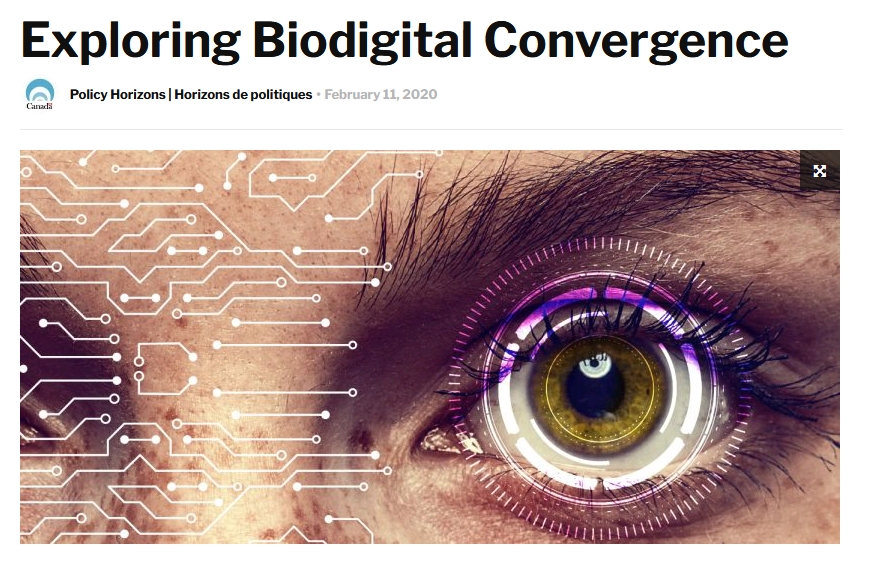
|
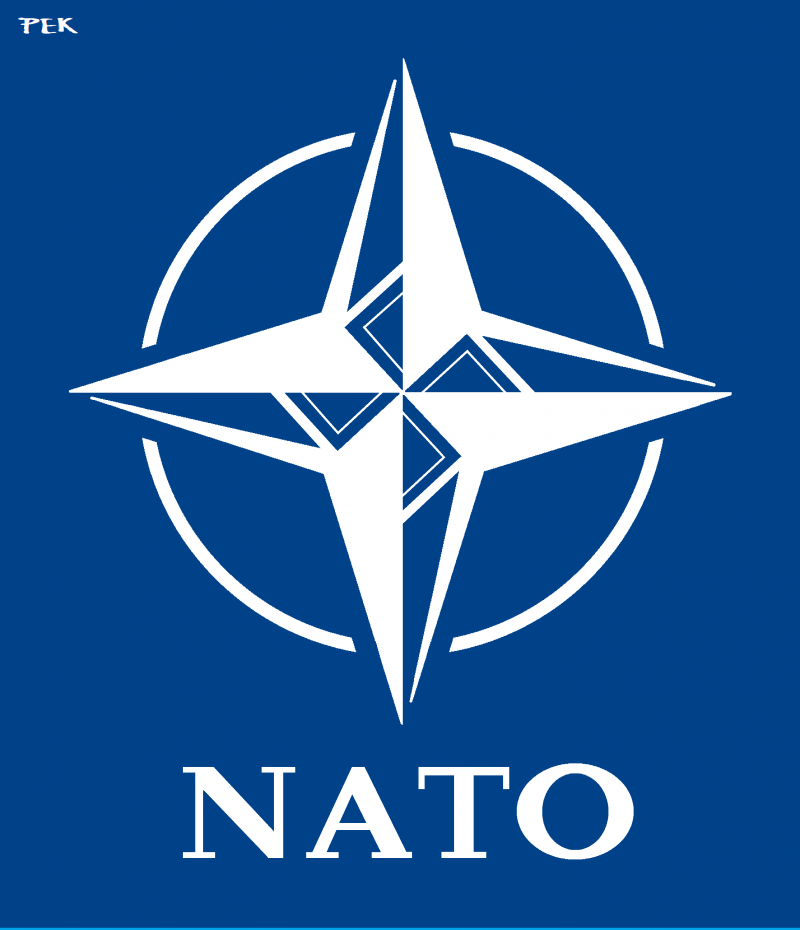
|
NATO
MEMS / Nanotechnology Integration for Bio-Medical Applications
The integration of MEMS and nanotechnologies has resulted in new capabilities for environmental monitoring and bio-nano sciences. The capabilities are enabled through a new type class of gas sensors and novel techniques for identifying and
manipulating biological cells.
The use of MEMS technology for exploring the bio-nano space has resulted in ultra-sensitive molecular detection at much reduced weight and footprint for health monitoring
(and also bio warfare agent surveillance).
Nato - Klaus Schadow
|
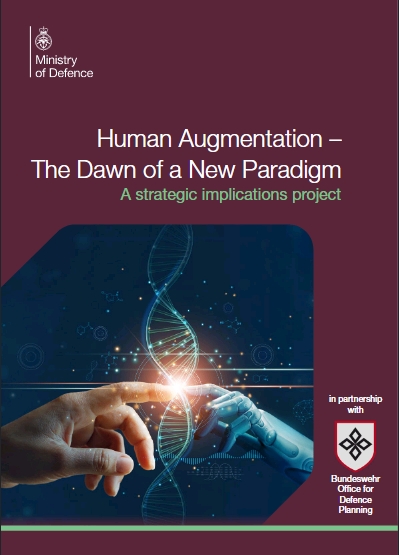
|
UK MOD & German Defense
Human Augmentation
dawn of a new paradigm
The prospect of using technology to radically enhance human performance has been the subject of intense debate over the last two decades. Some analysis has been pessimistic and cautionary, downplaying just how imminent such technologies are. Other commentators are more optimistic and foresee an impending technological revolution that will radically transform every aspect of our lives. What is certain is that the field of human augmentation has the potential to transform society, security and defence over the next 30 years. We must begin to understand the implications of these changes and shape them to our advantage now, before they are thrust upon us.Technology in warfare has traditionally centred on increasingly sophisticated platforms that people move and fight from, or artefacts that they wear or wield to fight with. Advances in the life sciences and converging developments in related fields are, however, beginning to blur the line between technology and the human. Significant thought has already been given to what this means for artificial intelligence, automation and robotics, but comparatively little time has been given to what this means from a human perspective.
This project seeks to address this imbalance so that we can understand the potential of human augmentation and its implications. The project is a bilateral cooperation between Bundeswehr Office for Defence Planning in Germany and the Development, Concepts and Doctrine Centre in the UK. The output from the strategic implications project will be relevant to a wide audience across the defence and security sector. Whilst this is not a scientific publication, it draws extensively on research to provide an overview of where the key opportunities and threats are. Many technologies that have the potential to deliver strategic advantage out to 2050 already exist and further advances will undoubtedly occur. Our understanding of the technical, ethical, legal and societal implications of these technologies will be decisive in how transformative they prove to be for Defence. Our potential adversaries will not be governed by the same ethical and legal considerations that we are, and they are already developing human augmentation capabilities. Our key challenge will be establishing advantage in this field without compromising the values and freedoms that underpin our way of life.
|

|
[linked research] interesting stuff on the AI data surveillance / bio / genetic UK state
by Nafeez Ahmed May 2020 -
WhiteHall Analytica
also UK Column with Brian Gerrish & Debbi Evans in conversation
wellcome / lumina / biobank etc
PCR testing & The Genome Beast
Whitney Webb on The Last American Vagabond -
"BIOgenetics industry and eugenics links"
|
Next: